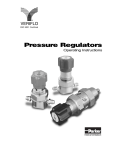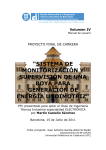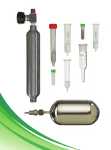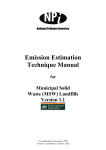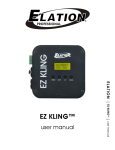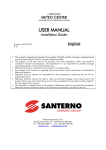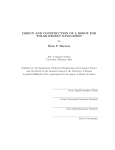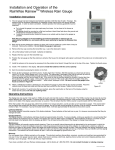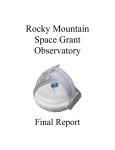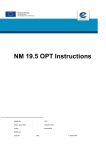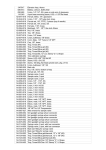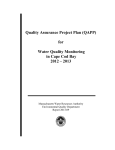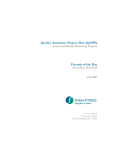Download 2011 GarCo QA Project Plan - Garfield County, Colorado
Transcript
QUALITY ASSURANCE PROJECT PLAN FOR THE GARFIELD COUNTY VOLATILE ORGANIC COMPOUNDS MONITORING PROGRAM Prepared for the GARFIELD COUNTY COMMISSIONERS 108 8th Street Glenwood Springs, CO 81601 COLORADO DEPARTMENT OF PUBLIC HEALTH AND ENVIRONMENT 4300 Cherry Creek Drive South Denver, CO 80246-1530 Prepared by 1901 Sharp Point Drive, Suite E Fort Collins, CO 80525 Phone: 970-484-7941 www.air-resource.com October 2011 11/18/2011 11/18/2011 Program: Garfield County VOC Monitoring Program QAPP Section No.: A Revision No.: 0 Date: October 2011 Page 2 of 23 ACRONYMS AND ABBREVIATIONS AC APCD ARS ASCII AVHRR BTEX Alternating Current Air Pollution Control Division (Colorado Dept of Public Health and Environment) Air Resource Specialists, Inc. American Standard Code for Information Interchange Advanced Very High Resolution Radiometer Benzene, Toluene, Ethylbenzene, and Xylenes CAS CD CDPHE CFR CMC CSATAM Columbia Analytical Services Compact Disc Colorado Department of Public Health and Environment Code of Federal Regulations Colorado Mountain Collect Community Scale Air Toxics Ambient Monitoring DNPH EPA ERG FID GCC GC/FID/MS 2,4-Dinitrophenylhydrazine Environmental Protection Agency Eastern Research Group, Inc. Flame Ionization Detector Garfield County Commissioners Gas Chromatograph/Flame Ionization Detector/Mass Spectrometry GC/MS GCPH HAP HPLC HPLC/UV ID Gas Chromatography/Mass Spectrometry Garfield County Public Health Hazardous Air Pollutant High Performance Liquid Chromatography High Performance Liquid Chromatography/Ultraviolet Identification LIMS MC MDL MS NATTS NIST Laboratory Information Management System Mass Concentration Minimum Detection Limits Microsoft National Ambient Toxics Trent System National Institute of Standards and Technology NMOC NOAA PAMS PC PDFID PM Non-Methane Organic Compounds National Oceanic and Atmospheric Administration Photochemical Assessment Monitoring Stations Personal Computer Pre-concentration and Direct Flame Ionization Detection Particulate Matter PSD QA QAPP SLAMS SNMOC SOP Prevention of Significant Deterioration Quality Assurance Quality Assurance Project Plan State and Local Air Monitoring Stations Speciated Non-Methane Organic Compound Standard Operating Procedure TI UATMP USB USGS UV VOC Technical Instruction Urban Air Toxics Monitoring Program Universal Serial Bus United States Geological Survey Ultraviolet Volatile Organic Compounds Program: Garfield County VOC Monitoring Program QAPP Section No.: A Revision No.: 0 Date: October 2011 Page 3 of 23 A PROJECT MANAGEMENT This section describes project management for the Garfield County Volatile Organic Compounds Monitoring Program, a joint Program of the Garfield County Commissioners (GCC), Garfield County Public Health (GCPH) and Colorado Department of Public Health and Environment (CDPHE). It includes Program history and objectives, roles and responsibilities of the participants, and document disposition. This section contains the following subsections: A1 A2 A3 A4 A5 A6 A7 A8 A9 Title and Approval Sheet Table of Contents Distribution List Program/Task Organization Problem Definition and Background Program/Task Description Quality Objectives and Criteria for Measurement Data Special Training Requirements/Certification Documentation and Records The following guidance has been used in the development of this Quality Assurance Project Plan (QAPP): 40 CFR 58: - Appendix A. Quality Assurance Requirements for SLAMS, SPMs and PSD Air Monitoring - Appendix C. Ambient Air Quality Monitoring Methodology - Appendix E. Probe and Monitoring Path Siting Criteria for Ambient Air Quality Monitoring 40 CFR 136: - Appendix B. Definition and Procedure for the Determination of the Method Detection Limit EPA Compendium Method TO-11A: Determination of Formaldehyde in Ambient Air Using Absorbent Cartridge Followed by High Performance Liquid Chromatography (HPLC) EPA Compendium Method TO-12: Determination of Non-Methane Organic Compounds (NMOC) in Ambient Air Using Cryogenic Pre-concentration and Direct Flame Ionization Detection (PDFID) EPA Compendium Method TO-14A: Determination Of Volatile Organic Compounds (VOCs) In Ambient Air Using Specially Prepared Canisters With Subsequent Analysis By Gas Chromatography Program: Garfield County VOC Monitoring Program QAPP Section No.: A Revision No.: 0 Date: October 2011 Page 4 of 23 EPA Compendium Method TO-15: Determination of Volatile Organic Compounds (VOCs) in Air Collected in Specially-Prepared Canisters and Analyzed by Gas Chromatography/Mass Spectrometry (GC/MS) EPA Quality Assurance Handbook for Air Pollution Measurement Systems: - Volume I, A Field Guide to Environmental Quality Assurance - Volume II, Ambient Air Quality Monitoring Program - Volume IV, Meteorological Measurements Meteorological Monitoring Guidance for Regulatory Modeling Applications Ambient Monitoring Guidelines for Prevention of Significant Deterioration (PSD) EPA Guidance for Quality Assurance Project Plans (QAPPs) EPA Requirements for Quality Assurance Project Plans (QAPPs) Program: Garfield County VOC Monitoring Program QAPP Section No.: A Revision No.: 0 Date: October 2011 Page 5 of 23 A2 TABLE OF CONTENTS Section A PROJECT MANAGEMENT A1 Title and Approval Sheet Acronyms and Abbreviations A2 Table of Contents A3 Distribution List A4 Program/Task Organization A5 Problem Definition and Background A5.1 Problem Definition A5.2 Background A6 Program/Task Description A6.1 Description of Work A6.2 Measurements A6.3 Assessment Requirements A6.4 Schedule A6.5 Reporting Requirements A7 Quality Objectives and Criteria for Measurement Data A7.1 Data Quality Objectives A7.2 Criteria for Measurement Data A7.2.1 Measured Parameters A7.2.2 Data Collection System A8 Special Training Requirements/Certification A9 Documentation and Records Page 3 1 2 5 8 8 10 10 10 11 12 14 15 15 16 16 16 16 16 17 18 18 Revision 0 0 0 0 0 0 0 0 0 0 0 0 0 0 0 0 0 0 0 0 0 0 Date 10/05/11 10/05/11 10/05/11 10/05/11 10/05/11 10/05/11 10/05/11 10/05/11 10/05/11 10/05/11 10/05/11 10/05/11 10/05/11 10/05/11 10/05/11 10/05/11 10/05/11 10/05/11 10/05/11 10/05/11 10/05/11 10/05/11 MEASUREMENT/DATA ACQUISITION B1 Sampling Process Design B2 Sampling Methods Requirements B3 Sample Handling and Custody Requirements B4 Analytical Methods Requirements B5 Quality Control Requirements B6 Instrument/Equipment Testing, Inspection, and Maintenance Requirements B6.1 Inspection and Acceptance Testing B6.2 Maintenance B7 Instrument Calibration and Frequency B8 Inspection/Acceptance Requirements for Supplies and Consumables B9 Data Acquisition Requirements for Non-Direct Measurements B10 Data Management 1 1 1 3 4 5 6 0 0 0 0 0 0 0 10/05/11 10/05/11 10/05/11 10/05/11 10/05/11 10/05/11 10/05/11 6 7 7 8 0 0 0 0 10/05/11 10/05/11 10/05/11 10/05/11 9 0 10/05/11 9 0 10/05/11 C ASSESSMENT/OVERSIGHT C1 Assessments and Response Actions C2 Reports to Management 1 1 2 0 0 0 10/05/11 10/05/11 10/05/11 D DATA VALIDATION AND USABILITY D1 Data Review, Validation, and Verification Requirements D2 Validation and Verification Methods D3 Reconciliation With User Requirements 1 1 1 2 0 0 0 0 10/05/11 10/05/11 10/05/11 10/05/11 1 0 10/05/11 B REFERENCES Program: Garfield County VOC Monitoring Program QAPP Section No.: A Revision No.: 0 Date: October 2011 Page 6 of 23 A2 TABLE OF CONTENTS (continued) Section APPENDIX A – Lists of Compounds Analyzed Page 1 Revision 0 Date 10/05/11 APPENDIX B – Chain-of-Custody Forms and Field Log Sheets 1 0 10/05/11 APPENDIX C – Eastern Research Group Quality Assurance Documents 1 0 10/05/11 APPENDIX D – Garfield County VOC Filter Change Schedules 1 0 10/05/11 APPENDIX E –2008 Ambient Air Monitoring Field Protocols 1 0 10/05/11 APPENDIX F – EPA Compendium Methods 1 0 10/05/11 APPENDIX G – Air Resource Specialists Meteorological Standard Operating Procedures and Technical Instructions 1 0 10/05/11 LIST OF FIGURES Figure A4-1 Garfield County VOC Monitoring Program Organizational Chart Section A Page 20 A6-1 Map of Garfield County VOC Monitoring Program Site Locations A 21 B1-1 Site Photographs – Glenwood Springs Courthouse B 12 B1-2 Site Photographs – New Castle-Library B 13 B1-3 Site Photographs – Silt-Cox Ranch B 14 B1-4 Site Photographs – Butterfly B 15 B1-5 Site Photographs – Silt-Bell Ranch B 16 B1-6 Site Photographs – Silt-Daley Ranch B 18 B1-7 Site Photographs – Brock B 19 B1-8 Site Photographs – Isley B 20 B1-9 Site Photographs – Thompson B 21 B1-10 Site Photographs – West Landfill B 22 B1-11 Site Photographs – Sebold B 23 B1-12 Site Photographs – Haire B 24 B1-13 Site Photographs – Rifle-Henry Building B 25 B1-14 Site Photographs – Parachute B 27 B1-15 Site Photographs – Battlement Mesa B 29 B10-1 Laboratory Data Management and Sample Flow Diagram B 33 D2-1 Meteorological Data Validation Flowchart D 3 Program: Garfield County VOC Monitoring Program QAPP Section No.: A Revision No.: 0 Date: October 2011 Page 7 of 23 LIST OF TABLES Table A6-1 Garfield County VOC Monitoring Program Instrumentation and Support Equipment A7-1 Monitoring Sensor and Sampling Specifications A 23 B1-1 Garfield County VOC Monitoring Program Geographic Specifications of the Monitoring Sites B 11 B6-1 VOC/NMOC Monitoring Systems Routine Operations and Maintenance Requirements B 30 B6-2 Carbonyl Monitoring Systems Routine Operations and Maintenance Requirements B 30 B6-3 PSD-Grade Meteorological Monitoring Systems Routine Operations and Maintenance Requirements B 31 Calibration Acceptance Criteria for the Garfield County VOC Monitoring Program B 32 B7-1 Section A Page 22 Program: Garfield County VOC Monitoring Program QAPP Section No.: A Revision No.: 0 Date: October 2011 Page 8 of 23 A3 DISTRIBUTION LIST The following individuals and/or organizations will receive copies of the approved Quality Assurance Project Plan (QAPP) and any subsequent revisions: Garfield County Public Health (GCPH) 195 West 14th Street, Rifle, CO 81650 Jim Rada, Environmental Health Manager Telephone: 970/625-5200 ext. 8113 Paul Reaser, Senior Environmental Health Specialist* Telephone: 970/625-5200 ext. 8123 Colorado Department of Public Health and Environment Air Pollution Control Division (CDPHE-APCD) 4300 Cherry Creek Drive South, Denver, CO 80246-1530 Gordon Pierce, Program Manager Cindy Wike, QA Specialist Telephone: 303/692-3238 Telephone: 303/692-3227 Air Resource Specialists, Inc. (ARS) 1901 Sharp Point Drive Suite E, Fort Collins, CO 80525 Lincoln Sherman, Project Manager Gloria Mercer, Quality Assurance Manager* Telephone: 970/484-7941 Telephone: 970/484-7941 * Indicates individuals who will maintain the official, approved QAPP. A4 PROGRAM/TASK ORGANIZATION Garfield County staff are the prime authority for this monitoring effort. They provide collection of the air samples and meteorological data. Prior to 2008, all volatile organic compound (VOC) samples were collected by Colorado Mountain College (CMC) under the direction of CDPHE or GCPH and analyzed by Columbia Analytical Services (CAS). Since 2008, Eastern Research Group, Inc. (ERG) provides canister/cartridge handling and laboratory analysis of the collected samples, and ARS provides regulatory meteorological data analysis and field support. A program organizational chart is shown as Figure A4-1. Responsibilities of key program participants are listed below. GCPH and CDPHE fund the program jointly and are the primary users of the data. During the 2005-2007 monitoring period, CDPHE operated the program jointly with GCPH; GCPH took over program management beginning in 2008 with CDPHE acting as an advisor since that time. GCPH is currently the lead agency and is responsible for all aspects of the monitoring program. Program: Garfield County VOC Monitoring Program QAPP Section No.: A Revision No.: 0 Date: October 2011 Page 9 of 23 Columbia Analytical Services (CAS) – Laboratory staff were responsible for sample canister preparation, shipping of sample canisters to the monitoring sites, receiving and processing samples shipped back from the field, VOC sample analysis, and laboratory data validation during the 2005-2007 monitoring period. They were also responsible for communicating operational problems to GCPH. Colorado Mountain College (CMC) – Staff at CMC were responsible for several of the initial monitoring locations and instrumentation as well as on-site instrument calibration and maintenance during the 2005-2007 monitoring period. Eastern Research Group, Inc. (ERG) – Julie Swift and staff are responsible for sample canister/cartridge preparation, shipping of sample canisters and cartridges to monitoring sites, receiving and processing samples shipped back from the field, sample analysis, and laboratory data validation during the 2008 to present monitoring period. They are also responsible for communicating operational problems to GCPH and providing data to the ARS project scientist. Site Operator – Paul Reaser, GCPH Air Quality Program Lead is the site operator for the program. He is responsible for overseeing the servicing of the monitoring sites and is responsible for the routine operation of the monitoring equipment and thorough field documentation of all collected data. Project Manager – Lincoln Sherman (ARS) is responsible for providing technical assistance to GCPH. Quality Assurance Manager – Gloria Mercer (ARS), is responsible for developing and maintaining the official, approved QAPP. Field Specialist – Mike Slate (ARS) is the field specialist for the PSD-grade meteorology sites that began operation in 2008. He is responsible for performing twice-annual calibrations and maintenance of the meteorology sensors. Site Auditor – Don Cobb (ARS) is the auditor for the PSD-grade meteorology sites that began operation in 2008. He is responsible for performing twice-annual performance audits of the meteorology sensors. Project Scientist – Cassie Archuleta (ARS) is responsible for the reporting of the collected data. She coordinates all phases of data management and archive with the analytical laboratory. Data Analysts – Emily Bitler, Laura Mack, and Matt Smith (ARS) are responsible for the daily collection, review, and preliminary meteorological data validation since 2008 of the PSD-grade meteorological monitoring sites. They assist in the preparation of reports, deliverable data files, and are responsible for data archive. Additional support personnel may be used as necessary upon direction of GCPH. Program: Garfield County VOC Monitoring Program QAPP Section No.: A Revision No.: 0 Date: October 2011 Page 10 of 23 A5 PROBLEM DEFINITION AND BACKGROUND A5.1 Problem Definition The Garfield County Volatile Organic Compounds Monitoring Program is designed to characterize the ambient air quality in Garfield County, Colorado. Data collected are used in a study of the risks to human health for citizens of Garfield County who are exposed to these pollutants. The objectives are to collect samples in towns and other populated areas of the county, and to evaluate whether air contaminants are being transported into the county from other regions. The County and surrounding areas are experiencing heavy oil and natural gas development. The volatile organic compounds (VOCs) and meteorology monitoring systems adhere to operational protocols established and accepted by the EPA, to provide scientifically defensible air quality data. The network is designed to yield data that will: Document and characterize concentrations of local scale VOCs to develop a baseline reference for long-term measuring. Build upon a previous monitoring study that identified data gaps for local source emissions. Implement a targeted approach to answer questions about the relationship between the air quality in Garfield County and human health risk. Develop the basis for decisions on how Garfield County can best manage impacts of air pollution caused by development. Establish the basis for a comprehensive community-based air quality management plan and implementation strategy using the best available scientific data and practices. A5.2 Background Garfield County and CDPHE developed an Ambient Air Quality Monitoring Study in 2005 to characterize ambient air quality within the County as a whole, in response to local citizen concerns about air pollution in the area and potential health effects, primarily due to the dramatic increase in oil and gas development activities. The two-year study (June 2005 through May 2007) was designed to meet the concerns of County residents, and to fit with and add to CDPHE and local industry air quality sampling efforts in an effort to make strong decisions with regard to managing air quality impacts from growth. During this period, monitoring for 43 specific VOCs was conducted at 14 sites for 24-hours on a once per month or once per quarter basis, and at 6 meteorological stations on a continuous basis. VOCs were collected using a Siltek® canister and analyzed at CAS following the U.S. Environmental Protection Agency’s Compendium Methods TO-14A and TO-15. In 2008, based on findings and recommendations from the 2005-2007 Ambient Air Quality Study and a CDPHE Screening-Level Health Risk Assessment, GCPH modified the Garfield County air quality monitoring program, reducing the number of monitoring sites, modifying the VOC analytical methods, and increasing sampling frequency to increase the amount of data collection and to maximize efficient use of available County funding. Program: Garfield County VOC Monitoring Program QAPP Section No.: A Revision No.: 0 Date: October 2011 Page 11 of 23 Monitoring beginning in 2008 focuses on better defining VOC issues in the community in the form of non-methane organic compounds (NMOC) and a variety of carbonyl compounds. Data are gathered on some hazardous air pollutants (HAPs) detected in the initial study, as well as several other compounds that have been implicated as ozone precursors (an interest for both Garfield County and the state of Colorado). Carbonyls were added due to implications in the occurrence of eye, skin, and respiratory irritation. Meteorological monitoring continued from the 2008 program to assist in determining the extent of travel of measured pollutants. Monitoring for NMOCs and carbonyl compounds (listed in Appendix A) is conducted at four sites for 24-hours. NMOC samples are collected using Siltek® canisters every 6 days and carbonyl compound samples are collected using DNPH-cartridges every 12 days. All NMOC and carbonyl samples are analyzed at ERG following EPA’s Compendium Methods TO-12 and TO-11A. This QAPP addresses all monitoring and data analysis procedures applied to the Garfield County Volatile Organic Compounds Monitoring Program. These procedures meet the protocols established by EPA and are fully documented in existing SOPs listed in Appendices C and F. Established EPA protocols are listed in the References section. Because of the complexity of this program, this document is organized by first addressing the 2005-2007 monitoring period, then the 2008 to present monitoring period. A6 PROGRAM/TASK DESCRIPTION Monitoring systems and parameters specifically include: 2005-2007 Volatile Organic Compounds (VOC) concentrations and meteorology parameters were monitored during 2005-2007 at 14 monitoring locations throughout the county. VOCs were collected through 24-hour integrated canister samples taken once per month or once per quarter according to EPA Compendium Methods TO-14A and TO-15. A list of samples analyzed is presented in Appendix A. Hourly average temperature, relative humidity, wind speed, wind direction, barometric pressure, and precipitation were monitored to record local atmospheric conditions at each location. Parameters were measured using a comprehensive, professional-grade but non-regulatory-grade weather station. 2008-Present Non-Methane Organic Compound (NMOC) concentrations, carbonyl compounds, and meteorology parameters are monitored during 2008 through the present at four monitoring locations. NMOCs are collected through 24-hour integrated canister samples taken once every six days according to EPA Compendium Method TO-12. Samples are analyzed for some of the same compounds that were analyzed prior to 2008 (e.g., BTEX compounds), along with a number of additional compounds (listed in Appendix A). Carbonyl compounds, including formaldehyde, acetaldehyde, acetone, and other aldehydes and ketones, as listed in Appendix A, are collected through 24-hour integrated cartridge samples taken once every 12 days according to EPA Compendium Method TO-11A. Program: Garfield County VOC Monitoring Program QAPP Section No.: A Revision No.: 0 Date: October 2011 Page 12 of 23 Hourly average temperature, relative humidity, wind speed, wind direction, and precipitation are monitored to record local atmospheric conditions at each location. All of the four monitoring sites continued to operate weather stations installed during the 2005-2007 monitoring period until 2009. The Rifle (Henry Bldg) and Parachute sites converted to regulatory-grade meteorological instrumentation in 2009 and 2010 respectively. These units follow Environmental Protection Agency (EPA) PSD protocols. A6.1 Description of Work Work to be performed for the Garfield County VOC Monitoring Program has been divided into four tasks as detailed below: 2005-2007 1) Site Selection and Equipment Procurement – Site selection and project methods were the responsibility of Garfield County in coordination with CDPHE. The Colorado Department of Public Health and Environment – Air Pollution Control Division provided some program support throughout all phases of project work. The 14 monitoring locations were selected to describe the exposure of the general population of Garfield County to VOCs primarily related to urban growth areas and from oil and gas development activities. Sites were selected based on proximity of area and emission sources, accessibility and security, and cooperation of land or building owners. A map of the region with location of the monitoring sites is presented as Figure A6-1. Instrumentation and related equipment procured included sampling canisters, meteorological sensors, and data acquisition systems. 2) Installation – After site selection and land use authorizations were complete, GCPH contracted with Colorado Mountain College (CMC) to perform some equipment installations. CDPHE APCD provided some equipment and performed installations and other tasks. CDPHE field staff installed the instrumentation verified its operation (and compliance with 40 CFR 58, TO-14A, and TO-15), calibrated the systems if required, and trained the site operator. Table A6-1 details the monitoring and support equipment used for the Garfield County VOC Monitoring Program. 3) Field Operations – Garfield County contracted with CMC as the designated site operator. The operator was fully trained and was provided with needed support equipment, forms, and monitoring supplies. Field operations include equipment maintenance and sample changing. CMC and CDPHE staff provided periodic on-site calibrations and maintenance of the instrumentation. VOC samples were retrieved once per month or once per quarter based on the EPA sampling schedule and shipped to the laboratory for analysis. Samples were collected in Siltek® stainless steel canisters and analyzed at CAS using gas chromatograph/mass spectrometer analysis following TO-14A and TO-15 guidelines. All meteorological data were retrieved via hand-held computer and were sent to GCPH staff. Meteorological measurements included air temperature, relative humidity, wind speed, wind direction, barometric pressure, and precipitation. CMC performed meteorological data downloads on a routine basis. 4) Data Operations – VOC data were managed at the analytical laboratory (CAS), and the data were reported to GCPH. All meteorological data were collected and managed by GCPH. Program: Garfield County VOC Monitoring Program QAPP Section No.: A Revision No.: 0 Date: October 2011 Page 13 of 23 2008-Present 1) Site Selection and Equipment Procurement – Program methods are the responsibility of Garfield County Public Health (the lead agency), with CDPHE as an advisor in the program. Four of the initial monitoring locations continued through this newly revamped program, to describe the exposure of the general population of Garfield County to NMOCs and carbonyl compounds related to urban growth and oil and gas development activities. One of the four sites is designated to be a mobile station that will change locations on an as-needed basis. A map of the region with location of the monitoring sites is presented as Figure A6-1. Instrumentation and related equipment procured includes sampling canisters and cartridges, sampling pumps, meteorological sensors (air temperature, wind speed, wind direction, barometric pressure, and precipitation), data acquisition systems, and support systems. Two monitoring sites replaced their meteorological weather stations with PSD-grade meteorological sensors in 2009 and 2010. 2) Installation – Four of the existing sites were selected to remain in operation for this program. Field staff installing new instrumentation verified its operation (and compliance with 40 CFR 58, TO-12 and TO-11A) calibrated the systems if required, and trained the site operator. Table A6-1 details the monitoring and support equipment used for the Garfield County VOC Monitoring Program. Weather stations were replaced with PSD-grade meteorological sensors at two monitoring locations, one in 2009 and another in 2010. 3) Field Operations – A local site operator was provided by GCPH. The operator was fully trained and provided with support equipment, forms, and monitoring supplies. The site operator performs field operations including equipment maintenance and sample changing. NMOC samples are collected during a 24-hour period every six days. Samples are collected in Siltek® stainless steel canisters and analyzed at ERG using GS/FID/MS analysis following TO-12 guidelines. Carbonyl samples are collected during a 24-hour period every 12 days and are shipped to the ERG laboratory for analysis. Samples are collected in DNPH-cartridges following TO-11A guidelines, using High Performance Liquid Chromatography (HPLC). Meteorological measurements at the two non-PSD-grade stations include air temperature, relative humidity, wind speed, wind direction, barometric pressure, and precipitation. The GCPH site operator provides periodic maintenance and performs meteorological data downloads on a routine basis. These meteorological stations were replaced in 2010 and 2011 with newer, all-in-one meteorology sensors, yet they remain non-PSD-grade. Meteorological measurements at the two PSD-grade stations include air temperature, relative humidity, wind speed, wind direction, and precipitation, and are maintained and calibrated twice-annually by ARS field staff. Data from PSD-grade stations are downloaded daily by ARS staff via cell phone communications for validation and archive. 4) Data Operations – All NMOC and carbonyl data are managed at the ERG analytical laboratory. The laboratory forwards an electronic file of data and analyses to the ARS Project Scientist, who prepares reports for GCPH staff. Meteorological data for the two PSD-grade monitoring stations are validated according to PSD guidelines at ARS. ARS applies fully documented data management techniques to yield the highest quality data collection and validation. Reporting includes quarterly and annual reporting, and data archive. Program: Garfield County VOC Monitoring Program QAPP Section No.: A Revision No.: 0 Date: October 2011 Page 14 of 23 A6.2 Measurements Table A6-1 summarizes instrumentation and measurement protocols that have been adopted by the EPA, are implemented throughout the United States, and are used in the Garfield County Volatile Organic Compounds Monitoring Program. Measurements for each parameter are summarized below: 2005-2007 Sampling for the VOCs of concern requires both whole air and sorbent sampling techniques. Siltek® canisters collected integrated samples collected over a period of 24 hours, once per month or once per quarter at 14 locations. Meteorological monitoring was performed at 6 stations using RainWise® model MK-III RTR stations for air temperature, relative humidity, wind speed, wind direction, barometric pressure, and precipitation. The stations were located on top of a tripod tower approximately 3 meters above the ground (the precipitation sensor was located at ground level). Data were stored on a 30-minute basis on a RainWise® CC-2000 computer interface were downloaded bi-weekly. Due to funding and location constraints, the meteorological monitoring did not meet EPA recommendations for regulatory requirements. 2008-Present NMOCs are collected over a sampling period of 24 hours on the EPA national 1-day-in-6 schedule, at four locations. In addition, carbonyl compounds collected on DNPH-coated silica gel sorbent cartridges using active sampling methodology are collected over a sampling period of 24 hours, on a 1-day-in-12 basis at the same four locations. The site operator installs the canisters and sorbent filters every 6 or 12 days according to the program schedule. They are retrieved and forwarded along with associated documentation to the analytical laboratory as soon after sampling as practical, typically within 24 hours. ARS obtains the validated data from ERG, applies appropriate calibrations, and includes the resulting concentration data in the program database. Data plots are prepared to graphically display the data. Meteorological data at the two non-PSD-grade monitoring sites are collected similar to the 2005-2007 monitoring period, but their instrumentation was upgraded. Data are retrieved from each station’s data logger onto a flashcard, which is then downloaded onto PC for data review. For the two PSD-grade sites, ambient temperature, relative humidity, wind speed, wind direction, and precipitation hourly average data are retrieved daily from each on-site data logger, and are reviewed daily and weekly to identify operational problems or data inconsistencies. Data are appended daily to the program database and are reduced to yield a Level-1 quality assured data set, as described in SOP 3450, Ambient Air Quality and Meteorological Monitoring Data Validation. Monthly plots of all meteorological parameters are supplemented with data summary statistical tables and monthly, quarterly, and annual wind rose plots. Program: Garfield County VOC Monitoring Program QAPP Section No.: A Revision No.: 0 Date: October 2011 Page 15 of 23 A6.3 Assessment Requirements 2005-2007 Program assessments include routine, periodic site operator servicing (once per month or once per quarter) to change the sample canisters, periodic field technician calibration/maintenance, and download of meteorological data. 2008-Present NMOC canisters and carbonyl cartridges are assessed prior to and following the scheduled 24-hour sampling period (every 6 days or every 12 days, respectively) by the site operator. The operator performs a physical inspection and determines if the systems have functioned properly over the previous 24-hour sampling period. Assessment includes verifying sorbent filter flow and canister/cartridge on/off times for the previous sampling period and recording on a chain-of-custody log sheet (see Appendix B). Log sheets accompany canisters and cartridges to the laboratory and are reviewed upon receipt. A physical inspection of the instruments is performed and the chain-of-custody log sheets are reviewed for thoroughness of information and data completeness. ERG performs standard laboratory assessments upon canister preparation (pre-sampling), canister return (post-sampling), and upon analysis. Complete procedures can be found in ERG’s document, Support for the EPA National Monitoring Programs (see Appendix C). Meteorological data from the two non-PSD sites are collected periodically using a flashcard plugged into the stations’ data loggers, then downloaded to a PC for review. Since data are non-PSD grade, they are not collected following any standard protocols. Meteorological data from the two PSD-grade sites are downloaded daily by ARS where they are reviewed to assess the operational integrity of the systems. This review includes an operational assessment of data completeness. In addition, an operator site visit occurs every six days to check the operational status and provide routine maintenance to all systems. An ARS field specialist travels to the site twice-annually to maintain and calibrate the meteorological sensors and systems according to EPA guidelines. Routine, scheduled maintenance is performed to assure quality data. For data collected by ARS, any monitoring inconsistency noted by any assessment initiates immediate corrective action. ARS logs the noted meteorological data collection problem and the corrective action timeline in the project Site Status Log. ARS reviews and assesses the problem and possible solution. Some problems are addressable through remote access to the site instrumentation or systems, while some require that ARS contact the site operator and guide them through system troubleshooting and repair, including individual component replacements. If a problem cannot be resolved remotely or with site operator assistance, ARS makes an emergency remedial repair visit to the site to isolate and correct the problem. A6.4 Schedule 2005-2007 Samples were collected once a month or once per quarter at each of the 14 monitoring locations following a defined project schedule. Appendix D presents the project schedules. Program: Garfield County VOC Monitoring Program QAPP Section No.: A Revision No.: 0 Date: October 2011 Page 16 of 23 2008-Present Samples are collected once every 6 or 12 days at each monitoring location. Appendix D includes example sample changing schedules for the period. A6.5 Reporting Requirements 2005-2007 A data summary report for data collected between 2005 and 2007 was prepared by CDPHE. 2008-Present Reporting requirements for the Garfield County VOC Monitoring Program include quarterly data submittals and annual reports specified by Garfield County. In general, reports include narratives describing the monitoring sites (including instrument location and configuration), data summaries, and general interpretation. Monthly progress reports are also prepared for the PSD stations, which contain summaries of instrument operation and data collection statistics. A7 QUALITY OBJECTIVES AND CRITERIA FOR MEASUREMENT DATA A7.1 Data Quality Objectives The minimum data recovery objective for the Garfield County VOC Monitoring Program is 90% per calendar quarter for each parameter. Actual data recovery is subject to instrument performance. There are no backup systems for any of the site instrumentation; catastrophic failure of a system could cause an extended downtime for an individual parameter. Measurement quality objectives for the 2008 to present monitoring period are provided in the Support for the EPA National Monitoring Programs document (see Appendix C). All laboratory procedures follow EPA Compendium Methods TO-14A and TO-15 (2005-2007), and TO-12 and TO-11A (2008-present). A7.2 Criteria for Measurement Data General guidance for the monitoring program will follow EPA documents listed in the References section. A7.2.1 Measured Parameters Each parameter has specific measurement performance criteria, which is generally applied during data validation. Table A7-1 presents sampling ranges and specifications for each measured parameter. 2005-2007 Sampling with a Siltek® canister and passive collection provide a time-integrated sample. Analysis of the sampling canisters was performed by gas chromatography using method TO-14A Program: Garfield County VOC Monitoring Program QAPP Section No.: A Revision No.: 0 Date: October 2011 Page 17 of 23 and GC/MS using method TO-15. See Appendix C for a summary of the analytical procedures. A chain-of-custody form and field procedure are presented in Appendix B. 2008-Present Sampling with a Siltek® canister and passive collection provide a time-integrated sample. Detection by mass spectrometer provides definitive identification of NMOCs. Analysis of sampling canisters is performed by GC/FID/MS according to TO-12. Appendix A is a list of compounds analyzed and measured for this program. Complete laboratory methods are provided in ERG’s document, Support for the EPA National Monitoring Programs (see Appendix C). Using a low flow, constant voltage vacuum pump, carbonyl samples are collected on DNPH-coated sorbent cartridges. Sampling manifolds with data logger-controlled valves that allow for integrated sampling are used to collect the sorbent samples. Flow rate through the cartridge is computed by measuring the temperature of the cartridge and the pressure drop across it. The resulting calibration is applied to the data to determine concentrations. Cartridges are desorbed in the laboratory using a solvent, and the extract is analyzed by HPLC/UV. Carbonyls are analyzed following TO-11A. Appendix A provides a list of compounds analyzed and Appendix C contains a summary of analytical procedures. The network currently consists of two monitoring stations that do not follow any standard protocols for meteorology and two stations that converted their meteorological instrumentation to PSD-grade. Detailed discussions of the operational criteria for each are presented in SOP 3150, Calibration and Routine Maintenance of Meteorological Monitoring Systems. Data are validated to Final (Level-1) validation as described in SOP 3450, Ambient Air Quality and Meteorological Monitoring Data Validation. A7.2.2 Data Collection System Data collection systems for the program include sample collection canisters, sample collection cartridges, and meteorological stations and sensors. 2005-2007 VOCs were collected directly from Siltek® canister samples. All sampling media were shipped to the analytical laboratory by traceable carrier in laboratory-supplied containers that fully meet sample handling and transport requirements. Chain-of-custody accounting was fully documented by shipping records, shipping logs, and field sampling log sheets. Temperature, cartridge pressure drop, and sample on/off times were recorded by the on-site data collection system. All meteorological data were captured on-site by the data collection system, consisting of a RainWise® weather station and data logger. Data were downloaded bi-weekly using a Palm Pilot and software; see Appendix E, Garfield County Ambient Air Monitoring Field Protocol, for complete procedures. Program: Garfield County VOC Monitoring Program QAPP Section No.: A Revision No.: 0 Date: October 2011 Page 18 of 23 2008-Present NMOCs and carbonyl compounds data are collected directly from Siltek® canisters and sorbent cartridges, respectively. All sampling media are shipped to the analytical laboratory (ERG) by traceable carrier in laboratory-supplied containers that fully meet sample handling and transport requirements. Chain-of-custody accounting is fully documented by shipping records, shipping logs, and field sampling log sheets. Temperature, cartridge pressure drop, and sample on/off times are recorded on chain-of-custody log sheets. Meteorological data for the non-PSD-grade sites were captured on-site by the data collection system, consisting of a RainWise® weather station and data logger. Data were periodically downloaded using a Palm Pilot and software. (see Appendix E). In 2010 and 2011, the instrumentation was upgraded to a Climatronics All-in-One weather sensor. Data are periodically downloaded from the stations’ data loggers to a flashcard. Meteorological data for the PSD-grade sites are captured on-site by the data collection system consisting of a data logger and cellular modem. The cellular modem provides a remote link to the site for data/documentation collection and operational status assessment. The data logger is capable of storing a minimum of 30 days of continuous data for all parameters and can be polled on-site if the cellular modem fails. A8 SPECIAL TRAINING REQUIREMENTS/CERTIFICATION Laboratory analysts hold academic degrees in a related field and are fully trained in the use of laboratory equipment and procedures. ARS staff working on this project are experienced in ambient air quality and meteorological monitoring systems. The project manager is responsible for verifying all staff members are fully informed on the specific monitoring and data management configurations for this project. Staff are informed/trained on a one-to-one basis. Site operators are fully trained on-site by ARS field staff. ARS data analysts are fully trained by the project manager on operational properties and expectations of all monitoring instrumentation, data acquisition systems, and calibration and maintenance procedures. Data analysts are also trained on all data collection, validation, and reporting software tools used in network data management. Their primary expertise resides in their ability to review data for quality and completeness and to perform the highest quality validation. No specific professional certifications of data analysts are required, but data analysts are thoroughly trained in all aspects of their job requirements. A9 DOCUMENTATION AND RECORDS All hardcopy records, digital data, and other documents reside at the analytical laboratories, GCPH, and in the ARS project database for the life of the program or at least for five years, whichever is greater. All raw and validated data are duplicated quarterly and delivered with the quarterly reports to designated recipients. At the end of the program all data and records Program: Garfield County VOC Monitoring Program QAPP Section No.: A Revision No.: 0 Date: October 2011 Page 19 of 23 will be turned over to program participants or their designee. The following types of documentation and records are used in the Garfield County VOC Monitoring Program: Field documentation including log sheets, instrument printouts, calibration results, quality control checks, laboratory procedures, and maintenance performed will be delivered to program participants upon program termination. The site operator completes instrument-specific log sheets (manual or digital) during each site visit. Program data (raw and validated) reside in the laboratory’s LIMS database and in ARS’ project database, and are available for use during the life of the program. A digital copy on compact disc (CD) of raw and validated data is delivered quarterly to the program participants. Upon program termination, all data will be archived on CD and delivered to program participants. Program reports (quarterly and final) are produced by ARS according to the needs of program participants. These reports are produced in digital format in Microsoft Word and printed as hardcopy for distribution. Upon program termination all reports and associated graphical products will be archived on CD and delivered to program participants. Program: Garfield County VOC Monitoring Program QAPP Section No.: A Revision No.: 0 Date: October 2011 Page 20 of 23 Garfield County Commissioners Garfield County Public Health Department Colorado Department of Public Health and Environment Air Pollution Control Division Site Operator Jim Rada / Paul Reaser Chemistry Meteorology Laboratory Analysis and Reporting Field Operations Columbia Analytical Services Colorado Mountain College 2005-2007 Monitoring Period Chemistry Field Operations/Non-Regulatory Meteorology PSD-Regulatory Meteorology Garfield County Public Health Paul Reaser Air Resource Specialists, Inc. Project Manager Lincoln Sherman Laboratory Analysis and Reporting Eastern Research Group Julie Swift Quality Assurance Gloria Mercer Field Operations Mike Slate Field Audits Don Cobb Data Management Emily Bitler Laurie Mack Matt Smith Reporting Cassie Archuleta 2008-Present Monitoring Period Figure A4-1. Garfield County VOC Monitoring Program Organizational Chart. 2005-2007 Monitoring Period Program: Garfield County VOC Monitoring Program QAPP Section No.: A Revision No.: 0 Date: October 2011 Page 21 of 23 Monitoring Locations During 2005-2007 Monitoring Locations During 2005-2007 Yellow = mobile stations Red = fixed stations Monitoring Locations Beginning 2008 Figure A6-1. Maps of Garfield County VOC Monitoring Program Site Locations. Program: Garfield County VOC Monitoring Program QAPP Section No.: A Revision No.: 0 Date: October 2011 Page 22 of 23 Table A6-1. Garfield County VOC Monitoring Program Instrumentation and Support Equipment. Equipment Type Manufacturer and Model Sampling Frequency Parameter Air toxics canister Siltek® Quarterly/monthly Data derived from laboratory (prior to 2008) analysis of canisters 24-hour averages on 1-day-in-6 EPA schedule (beginning 2008) Flow controller Veriflo SC423XL VOC/NMOC Carbonyls (beginning 2008) DNPH-cartridges SKC 224-PCXR8 Series Gas flow calibrator Bios Defender 500 Series Sorbent tubes Waters Sep-Pak XPoSure WAT047205 Ozone scrubber cartridges Waters WAT054420 24-hour averages on Data derived from laboratory 1-day-in-12 EPA schedule analysis of cartridges (beginning 2008) Sampling pumps Meteorology Non-PSD-grade weather station: Ambient temperature Relative humidity Wind speed and direction Barometric pressure Precipitation Data logger RainWise MK-III RTR Continuous Hourly averages RainWise PSD-grade sensors (beginning 2008) Ambient temperature Vaisala HMP45C aspirated 1-second samples; hourly averages Relative humidity Vaisala HMP45C aspirated 1-second samples; hourly averages Wind speed and wind direction R.M. Young 5305 1-second samples; hourly average with 15-minute subintervals (900 samples per subinterval) 1-second samples; hourly average with 15-minute subintervals (900 samples per subinterval) Wind Direction Sigma Theta R.M. Young 05305 Precipitation MetOne Model 385 Hourly accumulation Data logger derived Program: Garfield County VOC Monitoring Program QAPP Section No.: A Revision No.: 0 Date: October 2011 Page 23 of 23 Table A7-1. Monitoring Sensor and Sampling Specifications. Parameter Sensor ® Units and Range Sample Frequency Notes 3 24-hour averages on 1-day-in-6 EPA schedule Data derived from laboratory analysis of canisters VOCs Siltek canister µg/m NMOCs Siltek® canister µg/m3 24-hour averages on 1-day-in-6 EPA schedule Data derived from laboratory analysis of canisters Carbonyls Sorbent filters µg 24-hour averages on 1-day-in-12 EPA schedule Data derived from laboratory analysis of cartridges Weather Station: Air temperature Relative humidity Wind speed Wind direction Barometric pressure Precipitation RainWise MKIII RHR Air Temperature Vaisala HMP45C C -30 C to +50 C Relative Humidity Vaisala HMP45C 0% to 100% Wind Speed and Wind Direction R.M. Young 05305 m/s and degrees true 0 to 360 1-second samples; hourly average with 15-minute subintervals (900 samples per subinterval) Wind Direction Sigma Theta R.M. Young 05305 Degrees 1-second samples; hourly average with 15-minute subintervals (900 samples per subinterval) Precipitation MetOne 385 Continuous C 0% to 100% 0 to 360 1-second samples; hourly averages Hourly accumulation Data logger derived Program: Garfield County VOC Monitoring Program QAPP Section No.: B Revision No.: 0 Date: October 2011 Page 1 of 33 B MEASUREMENT/DATA ACQUISITION This section describes the program design and implementation of the Garfield County VOC Monitoring Program, including collecting, handling, and analyzing the data; using data from other sources; and managing and validating the data. This section includes the following subsections: B1 B2 B3 B4 B5 B6 B7 B8 B9 B10 Sampling Process Design Sampling Methods Requirements Sample Handling and Custody Requirements Analytical Methods Requirements Quality Control Requirements Instrument/Equipment Testing, Inspection, and Maintenance Requirements Instrument Calibration and Frequency Inspection/Acceptance Requirements for Supplies and Consumables Data Acquisition Requirements for Non-Direct Measurements Data Management B1 SAMPLING PROCESS DESIGN The Garfield County VOC Monitoring Program sampling process was designed to collect adequate samples and data in populated areas of the county sufficient to describe the exposure of the general population of the county to VOCs, and to evaluate whether air contaminants are being transported into the county from other regions. Measurement methods meet EPA’s Compendium of Methods for the Determination of Toxic Organic Compounds in Ambient Air performance criteria and provide detailed documentation for determining minimum detection limits (MDL) for each of the compounds. MDL development is performed in accordance with 40 CFR 136, Appendix B requirements. These standard protocols were specified by Garfield County to assure data collected by the program are scientifically defensible. Sampling frequencies and instrumentation used in the program are described in Section A6. All measurements described in Section A6 are critical to achieve program objectives. The 2005-2007 monitoring period included 14 monitoring locations, 4 of which continued monitoring in 2008. Table B1-1 presents geographic specifications of the Garfield County monitoring locations. Figures B1-1 through B1-15 present a satellite image and cardinal direction photographs (if available) of each monitoring location. B2 SAMPLING METHODS REQUIREMENTS Sampling methods for data collection for the Garfield County VOC Program are discussed below. 2005-2007 VOC canisters were changed every month or every quarter by the site operator, as defined by the program schedule. The schedule followed the EPA protocol schedule as great an Program: Garfield County VOC Monitoring Program QAPP Section No.: B Revision No.: 0 Date: October 2011 Page 2 of 33 extent as possible. A supply of canisters was shipped directly to the site operator from the analytical laboratory (CAS) between sample days. The site operator exchanged exposed canisters with new ones without handling samples directly. In addition to shipping full canisters to the analytical laboratory, the operator was also responsible for measuring and recording vacuum readings before and after Siltek® canister changes, and documenting the elapsed time of the data collection period. Meteorological data were retrieved bi-weekly via Palm Pilot and software from the on-site RainWise data logger. The site operator delivered the data to Garfield County staff for review. These data were not regulatory-compliant; however, they did provide an understanding of meteorological conditions during the sampling period. 2008-Present NMOC canisters are exchanged every 6 days by the site operator. The systems run on a standard EPA schedule of operating for 1 day every 6 days. Canisters are turned on manually between 8:00 and 11:00 am on the scheduled sampling day and run for 24 hours. A supply of canisters is shipped directly to the site operator from the analytical laboratory (ERG) between sample days. The canisters contain 4 to 6 liters of sampled air over a 24-hour period using a vacuum range of 29.9 to 7 inHg. The site operator retrieves the exposed canisters immediately after the 24-hour sampling period. In addition to shipping full Siltek® canisters to the analytical laboratory, the operator also measures and records vacuum readings before and after canister changes, and documents the elapsed time of the data collection period. Canisters are shipped back to the laboratory along with their chain-of-custody forms within 24 hours of sampling. Canisters are evacuated at the laboratory within 30 days of sample collection. Specific sampling protocols are documented in the GARCO 2008 Ambient Air Monitoring Field Protocol document (See Appendix E). Appendix B is an example chain-of-custody log sheet the operator completes for each station visit and canister exchange. Carbonyl cartridges are exchanged every 12 days by the site operator. The systems run on a standard EPA schedule of operating for 1 day every 12 days. They are turned on manually between 8:00 and 11:00am on the scheduled sampling day and run for 24 hours. A supply of cartridges is shipped directly to the site operator from the analytical laboratory (ERG) between sample days. Cartridges sample air over a 24-hour period using a flow rate of 600 to 800 mL/min. The site operator exchanges the exposed cartridges with new ones without handling the samples directly. In addition to shipping exposed cartridges to the analytical laboratory, the operator also measures and records flow rates before and after cartridge changes, and documents the elapsed time of the data collection period. Cartridges are shipped to the site in a cooler maintaining 4 C temperature. After sampling, the cartridges are again kept under refrigerated conditions, and are refrigerated upon receipt at the laboratory until analysis is performed. Specific sampling protocols are documented in the GARCO 2008 Ambient Air Monitoring Field Protocol document (see Appendix E). Appendix B is an example chain-of-custody log sheet the operator completes for each station visit and cartridge exchange. Meteorology parameter data for the two non-PSD sites (RainWise-instrumented sites) are collected similarly to the 2005-2007 period. Data are retrieved bi-weekly via Palm Pilot and software from the on-site RainWise® data logger. These data are not regulatory-compliant; however, they do provide an understanding of meteorological conditions during the sampling period. In 2010 and 2011, these stations were upgraded to a Climatronics All-in-One sensor Program: Garfield County VOC Monitoring Program QAPP Section No.: B Revision No.: 0 Date: October 2011 Page 3 of 33 system with data logger. Data are retrieved periodically on flashcard and downloaded to a personal computer for review. This new sensor system is also a non-regulatory-compliant system. Meteorology parameter data for the two PSD-grade sites are automatically retrieved daily via cellular telephone modem from the on-site data logger. If necessary, ARS data analysts collect data from the sites if the automatic process fails. Data are stored in the ARS Air Quality Database. Any data collection problems are immediately reported to the ARS project manager who immediately implements corrective actions. Data are collected according to EPA protocols and are detailed in SOP 3350, Collection of Ambient Air Quality and Meteorological Monitoring Data and Site Documentation. B3 SAMPLE HANDLING AND CUSTODY REQUIREMENTS 2005-2007 Sample handling and custody procedures for VOC canisters and data were defined by the analytical laboratory (CAS). VOC sampling was performed with 6-liter Siltek® canisters to provide time-integrated samples. Prepared canisters were shipped to the site operator via overnight delivery service by the analytical laboratory. Collection occurred unattended and required only a clean, evacuated Siltek® canister and a mass flow controller. A valve on the inlet manifold on the canister was opened at the start of the sampling period. At the end of the sample collection period, the valve was closed and the canister was shipped back to the laboratory for analysis. No preservation was required during shipping, and sample hold time was 30 days. The operator set up sample media on the specified sample date and completed a sample-specific log sheet. The canister was also tagged to identify the canister, site, and sample date. All media were shipped to the analytical laboratory by traceable carrier in laboratory supplied containers that fully met sample handling and transport requirements. Chain-of-custody accounting was fully documented by shipping records, shipping logs, and field sampling log sheets. Canisters were cleaned prior to reuse according to standard laboratory procedures. Meteorological data were non-PSD-grade and were collected directly from each site from data logger download by the site operator or CMC. The data were then delivered to Garfield County staff for review. 2008-Present NMOC sampling is performed with 6-liter Siltek® canisters to provide time-integrated samples. Prepared canisters are shipped to the site operator via overnight delivery service by the analytical laboratory. Collection occurs unattended and requires only a clean, evacuated Siltek® canister and a mass flow controller. A valve on the canister’s inlet manifold is operated at the start of the sampling period. At the end of the sample collection period, the valve is closed and the canister is shipped back to the laboratory by traceable carrier in laboratory-supplied containers that fully meet sample handling and transport requirements. No preservation is required during shipping; sample hold time at the laboratory is 30 days. The operator exchanges the sample media between sample days and completes a sample-specific log sheet (see Appendix B). The canister is also tagged to identify the canister, site, and sample days. All media is shipped to the analytical laboratory by traceable carrier in laboratory supplied containers that Program: Garfield County VOC Monitoring Program QAPP Section No.: B Revision No.: 0 Date: October 2011 Page 4 of 33 fully meet sample handling and transport requirements. Chain-of-custody accounting is fully documented by shipping records, shipping logs, and field sampling log sheets. Canisters are cleaned prior to reuse per SOP ERG-MOR-062. Carbonyl samples are collected on DNPH-coated sorbent cartridges. Cartridges are shipped to the site operator via overnight delivery service in coolers maintaining a temperature of 4 C by the analytical laboratory. Collection information includes cartridge temperature and pressure drop. After collection, the site operator exchanges sample media on the designated day and completes a sample-specific log sheet (see Appendix B). The operator ships the samples back to the laboratory via shipping carrier in the coolers they came in by traceable carrier in laboratorysupplied containers that fully meet sample handling and transport requirements (samples are shipped back to the laboratory at approximately 4 C). Sample hold time at the laboratory is two weeks. Chain-of-custody accounting is fully documented by shipping records, shipping logs, and field sampling log sheets. Samples received at the laboratory are logged into the Laboratory Information Management System (LIMS) database according to SOP ERG-MOR-045 and ERGMOR-079. After sample identification number, date received, sample date, etc. is reviewed for discrepancies. ERG contacts the site operator for resolution of any sample issues. ERG provides validated data files to GCPH, who in turn, provides files to ARS for quarterly and annual reporting purposes. Meteorological data at the non-PSD-grade sites are collected directly from each site from data logger download by the site operator. The data are then delivered to Garfield County staff for review. Meteorological data retrieval at the PSD-grade sites is performed automatically via cellular telephone modem from the data logger to ARS; data values are stored in the ARS Air Quality Database. Data are also stored on the data logger for 30 days, and may be retrieved via portable computer. B4 ANALYTICAL METHODS REQUIREMENTS Analytical methods for data collection for the Garfield County VOC Monitoring Program are discussed below. 2005-2007 Samples were collected using Siltek® canisters and analyzed at the CAS laboratory to provide definitive identification of specific VOCs. CAS performed analysis of the sampling canisters using GC/MS by method TO-15, as summarized in Appendix F. A list of the compounds analyzed is presented in Appendix A. Meteorology instruments and data required no analytical methods. Standard operating procedures for data collection and validation of the PSD-grade instruments are listed in Appendix G. Program: Garfield County VOC Monitoring Program QAPP Section No.: B Revision No.: 0 Date: October 2011 Page 5 of 33 2008-Present NMOC samples are collected with a Siltek® canister and analyzed at ERG laboratories to provide definitive identification of specific NMOCs; a complete list of chemicals analyzed in samples for this program is presented in Appendix A. ERG performs analysis of the sampling canisters within two weeks of sample collection using GC/FID/MS by Method TO-12 (see Appendix F) and ERG SOP-MOR-046. Carbonyl samples are collected on DNPH-coated sorbent cartridges. Sampling manifolds with data logger controlled valves are used to collect the sorbent samples. The flow rate through the cartridge is calculated using the temperature of the cartridge and the pressure drop across it. The resulting calibration is applied to the data to determine concentrations. Cartridges are stored in a refrigerator prior to analysis and are analyzed within 30 days of sampling collection. The cartridges are desorbed in the ERG laboratory using a solvent, and the extract is analyzed by HPLC/UV. Specific carbonyls are analyzed by TO-11A (see Appendix F) and ERG SOP-MOR-047. Meteorology instruments and data require no analytical methods. PSD-grade meteorology instruments undergo calibration twice-annually using National Institute of Standards and Technology (NIST)-traceable standards that receive annual certifications from individual manufacturers. B5 QUALITY CONTROL REQUIREMENTS Quality control requirements for the Garfield County VOC Monitoring Program are discussed below. They are also discussed in Sections B2, B3, B4, and B6. 2005-2007 VOC canisters were checked for leaks and cleaned prior to sampling. Compendium Method TO-15 includes provisions for inherent quality control in the analysis laboratory. Meteorological stations were calibrated upon installation and checked for operation by the site operator upon every site visit. 2008-Present NMOC canisters and sampling devices are checked for proper operation every six days by the site operator. At the laboratory, internal analytical standards and frequent verification of analytical system performance are used to control the analytical system. Compendium Method TO-12 includes provisions for inherent quality control in the analysis laboratory. Refer to the laboratory’s SOP for Standard Preparation Using Dynamic Flow Dilution System, ERG-MOR061) (see Appendix C). A 3-copy chain-of-custody form is shipped with each canister or cartridge to a site. Upon laboratory receipt, sample canister vacuum/pressure is compared against field documentation to ensure the canister remained airtight during transport. If any leaks are detected the sample is voided. Specific procedures are outlined in the SOP for Sample Receipt at the ERG Chemistry Lab, ERG-MOR-045. Program: Garfield County VOC Monitoring Program QAPP Section No.: B Revision No.: 0 Date: October 2011 Page 6 of 33 Samples are logged into the LIMS database following SOP ERG-MOR-079, Sample Login to the Laboratory Information Management System. Carbonyl tubes are extracted within 14 days of the sampling day and are refrigerated until analysis, which occurs within 30 days after extraction. Detailed sample receipt and acceptance policies are in SOP-MOR-045. Carbonyl sampling devices are checked for proper operation every 12 days by the site operator. At the laboratory, internal analytical standards and frequent verification of analytical system performance are used to control the analytical system. Compendium Method TO-11A includes provisions for inherent quality control in the analysis laboratory (see Appendix F). Non-PSD-grade meteorological stations are calibrated upon installation and checked for operation by the site operator upon every site visit. PSD-grade station sensors are serviced upon acceptance testing of a new instrument, upon installation or removal from a monitoring location, whenever control limits are exceeded, prior to any corrective action or maintenance that affects its operation, or at a maximum interval of six months. All meteorological systems are checked for proper operation every 12 days by the site operator. Specific control limits are described in SOP 3150, Calibration and Routine Maintenance of Meteorological Monitoring Systems. Quality control of the data is achieved through daily data review. B6 INSTRUMENT/EQUIPMENT TESTING, INSPECTION, AND MAINTENANCE REQUIREMENTS B6.1 Inspection and Acceptance Testing 2005-2007 VOC Siltek® canisters were inspected at the analytical laboratory before shipment to a monitoring location. They were accepted if no physical damage was present and if the canisters held a pressure/vacuum. When canisters were purchased they were cleaned, certified, and verified as meeting laboratory acceptance criteria. Each Siltek® canister and its associated flow controller were vacuum-tested by the site operator for leaks. Prior to deployment for sampling the flow controller was mounted to its canister, the system inlet was capped, and a vacuum was applied by momentarily opening (then closing) the canister valve. If leaks were present that were not resolved, the canister and gauge were not used and were returned to the laboratory. The meteorological station was calibrated at time of installation, and accepted if calibration resulted in normal parameter ranges of the instrument as defined by the manufacturer. 2008-Present NMOC Siltek® canisters are inspected at the analytical laboratory before shipment to a monitoring location. They are accepted if no physical damage is present and if the canisters hold a pressure/vacuum. When canisters are purchased they are cleaned, certified, and verified as meeting laboratory acceptance criteria. Each Siltek® canister and its associated flow controller are vacuum-tested by the site operator for leaks. Prior to deployment for sampling the flow controller is mounted to its canister, the system inlet is capped, and a vacuum is applied by momentarily opening (then closing) the canister valve. If leaks are present that are not resolved, the canister and gauge are not used and are returned to the laboratory. Program: Garfield County VOC Monitoring Program QAPP Section No.: B Revision No.: 0 Date: October 2011 Page 7 of 33 Carbonyl cartridges are inspected at the analytical laboratory before shipment to a monitoring location. They are accepted if no physical damage is present. The sampling pumps and flow calibrators receive an annual calibration, and the sample tubing is replaced as needed, or a minimum of twice each year. Non-PSD-grade meteorological stations were calibrated at time of installation, and accepted if calibration resulted in normal parameter ranges of the instrument as defined by the manufacturer. PSD-grade meteorological sensors are calibrated at the manufacturer. Sensors are accepted if documentation of the calibration and calibration results are received with the sensor. Refer to SOP 3150, Calibration and Routine Maintenance of Meteorological Monitoring Systems, for calibration procedures. These sensors are also audited twice-annually by an ARS auditor. B6.2 Maintenance Tables B6-1 through B6-3 summarize maintenance procedures for the measurement systems. 2005-2007 Regular maintenance of the canister systems was performed upon scheduled site operator visits. Meteorological stations received no periodic, scheduled maintenance. 2008-Present Regular maintenance of canister and cartridge systems is performed every 6 days and 12 days, respectively, as scheduled by the site operator. Tables B6-1 and B6-2 summarize the maintenance procedures for canister and sorbent cartridge systems, respectively. Calibration of laboratory GC/FID/MS instrumentation is performed quarterly. Non-PSD-grade meteorological stations receive no periodic, scheduled maintenance. PSD-grade maintenance is performed every 6 to 12 days, as scheduled by the site operator, and twice-annually by a field specialist. These maintenance procedures are detailed in SOP 3001, Procedures for Quarterly Maintenance to an Ambient Air Monitoring Station and SOP 3150, Calibration and Routine Maintenance of Meteorological Monitoring Systems. Table B6-3 summarizes maintenance procedures for meteorological sensors. B7 INSTRUMENT CALIBRATION AND FREQUENCY 2005-2007 Calibration of the analysis instrumentation was performed using generally accepted laboratory procedures. Siltek® canister samples were handled and analyzed by the analytical laboratory (CAS). Meteorological station calibrations were performed upon station installation at each location. 2008-Present Calibration of the instrumentation used to analyze the Siltek® canister samples is handled by the analytical laboratory (ERG) and calibration is performed quarterly. Carbonyl analysis instruments receive daily calibration checks. Similarly, calibration of the instrumentation used to analyze the sorbent filter cartridges is also handled by the analytical laboratory. Program: Garfield County VOC Monitoring Program QAPP Section No.: B Revision No.: 0 Date: October 2011 Page 8 of 33 Non-PSD-grade meteorological station calibrations are performed upon station installation at each location. Table B7-1 provides calibration acceptance criteria. PSD-grade meteorological sensor calibrations are performed twice-annually and after sensor repair or maintenance, according to SOP 3150, Calibration and Routine Maintenance of Meteorological Monitoring Systems, and include: Ambient Temperature – The temperature probe is calibrated on-site by comparing to a collocated reference temperature probe. Relative Humidity – The relative humidity sensor is calibrated using an audit sensor and portable data logger. The audit sensor is placed in an aspirator housing adapter and placed next to the existing station sensor, which ensures both probes are subjected to the same air stream. The audit sensor is left in place for several hours and data from both audit and station sensor are compared. Wind Speed – The wind speed sensor is calibrated at four shaft revolution speeds. The equivalent wind speed is calculated corresponding to the manufacturer’s specified values for shaft rpm versus wind velocity and compared to readings obtained from the on-site data logger. A bearing integrity check is performed with a torque wheel or a vane torque gauge. Wind Direction – The wind direction sensor is calibrated using a minimum of eight reference landmarks separated by approximately 45 degrees. Accuracy of the landmark bearings is verified by a minimum of two methods. In addition to sensor orientation and linearity checks, sensor bearings are tested using a torque wheel or a vane torque gauge. Precipitation – The tipping bucket rain gauge calibration is checked using a known volume of water introduced slowly into the gauge with a manufacturer-produced graduated cylinder. The designated value is compared with the recorded value. PSD-grade meteorological sensors are also audited twice-annually by ARS. B8 INSPECTION/ACCEPTANCE REQUIREMENTS FOR SUPPLIES AND CONSUMABLES 2005-2007 VOC canisters and chain-of-custody forms were provided by the analytical laboratory (CAS). They also provided chain-of-custody forms. No consumables were required for meteorological stations. 2008-Present Canisters, cartridges, hang tags, and chain-of-custody forms are provided by the analytical laboratory (ERG). No consumables are required for non-PSD-grade meteorological stations. For PSD-grade meteorological stations, certain components are replaced during each semiannual field specialist calibration visit. These include the bearings and potentiometer in the wind sensors. Operator log sheets are provided by ARS (see Appendix B). Program: Garfield County VOC Monitoring Program QAPP Section No.: B Revision No.: 0 Date: October 2011 Page 9 of 33 B9 DATA ACQUISITION REQUIREMENTS FOR NON-DIRECT MEASUREMENTS No non-direct measurements are currently used for the program. Information and non-direct measurements that may be used in conjunction with direct measurements may include aerial photographs of the western United States, and meteorology and visibility data collected in nearby areas. Satellite images may be taken with the National Oceanic and Atmospheric Association (NOAA) polar orbiter Advanced Very High Resolution Radiometer (AVHRR) satellites and are available on the World Wide Web. B10 DATA MANAGEMENT 2005-2007 VOC canisters were mailed directly to the site operator by the analytical laboratory. The site operator exchanged canisters without handling internal filters directly. Canisters were changed according to the program schedule by the site operator, who shipped exposed canisters back to the analytical laboratory for analysis. The operator also measured and recorded vacuum readings before and after the canister changes, and documented the elapsed time of each data collection period. Validation was performed by the analytical laboratory (CAS). All VOC data were provided by CMC to GCPH on a monthly basis in an electronic file format. Meteorological data were collected via Palm Pilot and downloading software. The site operator collected the data bi-weekly and delivered it to GCPH staff, where it was loaded onto a personal computer for review. These data were collected via professional-grade, but non-regulatory instruments. 2008-Present NMOC canisters and carbonyl cartridges are mailed directly to the site operator from the analytical laboratory. The site operator exchanges the canisters and cartridges without handling internal filters directly. The site operator changes canisters and cartridges every 6 or 12 days, respectively, according to the program schedule, and ships the exposed units to the analytical laboratory. The operator also measures and records vacuum readings before and after canister changes, and documents the elapsed time of each 24-hour data collection period. The operator records the temperature and cartridge pressure drop for existing and new cartridges. Validation is performed by the analytical laboratory (ERG) following the data processing steps summarized in Figure B10-1. The laboratory delivers digital data files to ARS for inclusion in reports and data archive. At the two non-PSD-grade stations, meteorological data are collected via Palm Pilot and downloading software. The site operator periodically collects the data and delivers the data set to GCPH staff, where it is loaded onto a personal computer for review. These data are collected via professional-grade, yet non-regulatory instruments. At the two PSD-grade stations, meteorological data are collected daily via cellular modem. ARS data analysts verify that all data are collected. Data are appended to the program database daily, and nightly backups of the database are performed. Data are reviewed daily to identify operational problems; data inconsistencies and complete validation is performed on a monthly basis. Archiving of raw data is performed on a monthly basis and archiving of all processed data is performed after data have Program: Garfield County VOC Monitoring Program QAPP Section No.: B Revision No.: 0 Date: October 2011 Page 10 of 33 been finalized and reported. All files are in American Standard Code for Information Interchange (ASCII) format. Files are stored in their original formats (non-compressed) on computer hard drives and CD and at least three copies of CDs are created. Hard copies of supporting documentation are archived on a continual basis. Complete procedures for data collection, processing, and archiving are presented in SOP 3350, Collection of Ambient Air Quality and Meteorological Monitoring Data and Site Documentation, and SOP 3450, Ambient Air Quality and Meteorological Monitoring Data Validation. Program: Garfield County VOC Monitoring Program QAPP Section No.: B Revision No.: 0 Date: October 2011 Page 11 of 33 Table B1-1. Garfield County VOC Monitoring Program Geographic Specifications of the Monitoring Sites. Site Name and Abbr. Elev. (ft) Latitude Longitude Land Use 2005-2007 Monitoring Period (VOC and Meteorology Monitoring Stations) Glenwood Springs – Courthouse 39° 32.843’N 107° 19.578’W 5823 Urban New Castle – Library Urban Silt-Cox Ranch 5574 39° 34.301’N 107° 32.080’W 5643 39° 33.976’N 107° 40.993’W Rural Butterfly 5981 39° 29.246’N 107° 37.693’W Rural, Oil/Gas Silt-Bell Ranch 5869 39° 29.148’N 107° 39.584’W Rural, Oil/Gas Silt-Daley Ranch 6378 39° 25.765’N 107° 38.464’W Rural Rifle 5351 39° 31.911’N 107° 46.932’W Urban Brock 6135 39° 29.306’N 107° 46.194’W Rural, Oil/Gas Isley 5833 39° 28.435’N 107° 51.528’W Rural, Oil/Gas Thompson 5951 39° 28.297’N 107° 51.561’W Rural, Oil/Gas West Landfill 5499 39° 30.895’N 107° 54.596’W Rural, Oil/Gas Sebold 5850 39° 27.886’N 107° 58.725’W Rural, Oil/Gas Haire 6017 39° 27.499’N 107° 58.742’W Rural, Oil/Gas Parachute 5125 39° 27.219’N 108° 03.196’W Urban, Oil/Gas 2008-Current Monitoring Period (NMOC, Carbonyl Compounds, and Meteorology Monitoring Stations) Rifle 39° 31.911’N 107° 46.932’W 5351 Urban Henry Building 144 3rd Street Parachute 39° 27.219’N 108° 03.196’W 5125 Urban Old High School 100 E. 2nd Street Silt 39° 29.148’N 107° 39.584’W 5869 Rural, Oil/Gas Bell-Melton Ranch 512 Owens Drive Mobile station: 39° 29.305’N 107° 46.194’W Brock (1/14/09 – 2/18/09) 6555 Rural , Oil/Gas Rulison (1/22/09 – 2/12/10) 5183 39° 29.324’N 107° 56.219’W Rural, Oil/Gas Battlement Mesa (9/18/10 – 5402 Urban, Oil/Gas 39° 26.125’N 108° 2.172’W current) Program: Garfield County VOC Monitoring Program QAPP Section No.: B Revision No.: 0 Date: October 2011 Page 12 of 33 Figure B1-1. Site Photographs – Glenwood Springs Courthouse. 6/2005-5/2007 Glenwood Springs Courthouse VOC Canister, looking northeast Program: Garfield County VOC Monitoring Program QAPP Section No.: B Revision No.: 0 Date: October 2011 Page 13 of 33 Figure B1-2. Site Photographs – New Castle – Library. 6/2005-5/2007 New Castle - Library VOC Canister, looking west-southwest Program: Garfield County VOC Monitoring Program QAPP Section No.: B Revision No.: 0 Date: October 2011 Page 14 of 33 Figure B1-3. Site Photographs – Silt – Cox Ranch. 6/2005-5/2007 Silt – Cox Ranch VOC, Particulate Matter (PM), and Meteorology looking west Program: Garfield County VOC Monitoring Program QAPP Section No.: B Revision No.: 0 Date: October 2011 Page 15 of 33 Figure B1-4. Site Photographs – Butterfly. 6/2005-5/2007 Butterfly Program: Garfield County VOC Monitoring Program QAPP Section No.: B Revision No.: 0 Date: October 2011 Page 16 of 33 Figure B1-5. Site Photographs – Silt – Bell Ranch (6/2005 – present) Silt – Bell Ranch VOC, PM, and Meteorology looking west 6/2005-5/2007 Program: Garfield County VOC Monitoring Program QAPP Section No.: B Revision No.: 0 Date: October 2011 Page 17 of 33 VOC, PM, and Meteorology looking east 5/2007-current Program: Garfield County VOC Monitoring Program QAPP Section No.: B Revision No.: 0 Date: October 2011 Page 18 of 33 Figure B1-6. Site Photographs – Silt – Daley Ranch. 6/2005-5/2007 Silt – Daley Ranch VOC looking west-southwest Program: Garfield County VOC Monitoring Program QAPP Section No.: B Revision No.: 0 Date: October 2011 Page 19 of 33 Figure B1-7. Site Photographs – Brock. 6/2005-1/2009 Brock Brock Program: Garfield County VOC Monitoring Program QAPP Section No.: B Revision No.: 0 Date: October 2011 Page 20 of 33 Figure B1-8. Site Photographs – Isley. 12/2005-5/2007 Isley Isley Program: Garfield County VOC Monitoring Program QAPP Section No.: B Revision No.: 0 Date: October 2011 Page 21 of 33 Figure B1-9. Site Photographs – Thompson. 6/2005-12/2005. Thompson Thompson *** no photo – short sampling period *** Program: Garfield County VOC Monitoring Program QAPP Section No.: B Revision No.: 0 Date: October 2011 Page 22 of 33 Figure B1-10. Site Photographs – West Landfill. 6/2005-5/2007 West Landfill West Landfill Program: Garfield County VOC Monitoring Program QAPP Section No.: B Revision No.: 0 Date: October 2011 Page 23 of 33 Figure B1-11. Site Photographs – Sebold. 6/2005-5/2007 Sebold Sebold Program: Garfield County VOC Monitoring Program QAPP Section No.: B Revision No.: 0 Date: October 2011 Page 24 of 33 Figure B1-12. Site Photographs – Haire. 6/2005-5/2007 Haire Haire Program: Garfield County VOC Monitoring Program QAPP Section No.: B Revision No.: 0 Date: October 2011 Page 25 of 33 Figure B1-13. Site Photographs – Rifle – Henry Building. 6/2005-present Rifle – Henry Building VOC, looking south-southwest Program: Garfield County VOC Monitoring Program QAPP Section No.: B Revision No.: 0 Date: October 2011 Page 26 of 33 VOC, looking east (later configuration) Program: Garfield County VOC Monitoring Program QAPP Section No.: B Revision No.: 0 Date: October 2011 Page 27 of 33 Figure B1-14. Site Photographs – Parachute. 6/2005-present Parachute Parachute, looking south-southwest Program: Garfield County VOC Monitoring Program QAPP Section No.: B Revision No.: 0 Date: October 2011 Page 28 of 33 Parachute, looking south-southwest (later configuration) Program: Garfield County VOC Monitoring Program QAPP Section No.: B Revision No.: 0 Date: October 2011 Page 29 of 33 Figure B1-15. Site Photographs – Battlement Mesa. 9/2010-current Battlement Mesa Battlement Mesa, looking west Program: Garfield County VOC Monitoring Program QAPP Section No.: B Revision No.: 0 Date: October 2011 Page 30 of 33 Table B6-1. VOC/NMOC Monitoring Systems Routine Operations and Maintenance Requirements. Air Toxics Systems Routine Field Procedures Procedure REGULAR MAINTENANCE (Site Operator) General site/system inspection Document the visit and pertinent events on the chain-of-custody log sheet ® Exchange Siltek canister, record vacuum on chain-of-custody form Ship spent canister and chain-of-custody form to analytical laboratory Frequency Monthly or quarterly (2005-2007) SCHEDULED MAINTENANCE (ARS Field Specialist) General site/system inspection Recalibrate/maintain passive flow controllers (sent to ERG) Every 12 months or as needed Every 6 days (2008-current) Table B6-2. Carbonyl Monitoring Systems Routine Operations and Maintenance Requirements. Carbonyl Systems Routine Field Procedures Procedure REGULAR MAINTENANCE (Site Operator) General site/system inspection Document the visit and pertinent events on the chain-of-custody log sheet Exchange sorbent cartridge and document on chain-of-custody form Ship spent cartridge and chain-of-custody form to analytical laboratory Frequency Every 12 days SCHEDULED MAINTENANCE (ARS Field Specialist) General site/system inspection Recalibrate/maintain sampling pumps (sent to SKC) Every 12 months or as needed Program: Garfield County VOC Monitoring Program QAPP Section No.: B Revision No.: 0 Date: October 2011 Page 31 of 33 Table B6-3. PSD-Grade Meteorological Monitoring Systems Routine Operations and Maintenance Requirements. PSD-Grade Meteorological System Routine Field Procedures Procedure REGULAR MAINTENANCE (Site Operator) Inspect overall system Observe freedom of wind vane and anemometer cups/prop Document observed weather conditions Verify that temperature and wind measurements appear reasonable Complete operator log sheet Frequency Every 6 days SCHEDULED MAINTENANCE (ARS Field Specialist) Pre-maintenance calibration check of wind and temperature sensors Perform system maintenance - Clean systems - Replace wind speed bearings - Replace wind vane potentiometer if required - Exchange temperature sensor with laboratory calibrated unit Post-maintenance calibration of all sensors Every 6 months Program: Garfield County VOC Monitoring Program QAPP Section No.: B Revision No.: 0 Date: October 2011 Page 32 of 33 Table B7-1. Calibration Acceptance Criteria for the Garfield County VOC Monitoring Program. Parameter Calibration Method VOC / NMOC Applicable Regulation Calibration Acceptance Criteria Frequency Criteria None N/A N/A N/A Carbonyls None N/A N/A N/A Temperature (PSD-grade) Collocated transfer standard (non-immersible sensors) Twiceannually Max error EPA QA Handbook for Air Pollution Measurement Systems: Vol IV ≤ ±0.5°C Relative Humidity (PSD-grade) Collocated reference standard Twiceannually Max error EPA QA Handbook for Air Pollution Measurement Systems: Vol IV ≤ ±7% Wind Speed (PSD-grade) Compare to calibrated motor at 4 speeds Twiceannually Max error EPA QA Handbook for Air Pollution Measurement Systems: Vol IV ≤ ±0.2 m/s at <5 m/s Wind Direction (PSD-grade) Solar azimuth, Precision compass, USGS map Twiceannually Max error EPA QA Handbook for Air Pollution Measurement Systems: Vol IV ≤ ±5° from true degrees at any designated point Precipitation (tipping bucket) (PSD-grade) Addition of known water volume Twiceannually Max error EPA QA Handbook for Air Pollution Measurement Systems: Vol IV ≤ ±10% of input volume Program: Garfield County VOC Monitoring Program QAPP Section No.: B Revision No.: 0 Date: October 2011 Page 33 of 33 Figure B10-1. Laboratory Data Management and Sample Flow Diagram. Program: Garfield County VOC Monitoring Program QAPP Section No.: C Revision No.: 0 Date: October 2011 Page 1 of 2 C ASSESSMENT/OVERSIGHT This section describes the activities for assessing implementation of the Garfield County Volatile Organic Compounds Monitoring Program and associated quality assurance/quality control (QA/QC) activities. This section includes the following subsections: C1 C2 Assessments and Response Actions Reports to Management C1 ASSESSMENTS AND RESPONSE ACTIONS 2005-2007 VOC analytical operations were assessed by CAS personnel in the laboratory. VOC and meteorological system operation were assessed during each site operator station visit. The site operator visited the stations according to the program schedule and assessed the physical condition of all systems including wiring and tubing. The operator also replaced sample media and consumable supplies as needed and shipped the spent canisters to the analytical laboratory. Appropriate documentation was completed for each instrument. This regular physical inspection of instrumentation helped to ensure collection of quality assured data. 2008-Present Assessments of the Garfield County VOC Monitoring Program include daily data checks, weekly operation checks, semiannual internal calibrations of the instrumentation, and twiceannual independent audits, as discussed below. Daily Data Review ARS data analysts download and review PSD-grade meteorological data daily. The review assesses operation of the systems, data completeness, and data quality. If any inconsistencies are noted, the program manager is notified and initiates corrective action. Site Visits Regular physical inspection of instrumentation is critical to collection of quality assured data. The site operator visits the stations every 6 or 12 days (canister sites and cartridge sites, respectively), and assesses the physical condition of all systems including wiring and tubing. The operator also reviews automated control checks and replaces sample media and consumable supplies as needed. The operator ships the spent canisters and cartridges to the analytical laboratory and completes documentation for each instrument. Laboratory Receipt and Analysis Canisters and cartridges are inspected upon receipt at the laboratory, along with their chain-of-custody forms, according to SOP ERG-MOR-045. Program: Garfield County VOC Monitoring Program QAPP Section No.: C Revision No.: 0 Date: October 2011 Page 2 of 2 Semiannual Calibrations Non-PSD-grade meteorological instrumentation do not receive any maintenance or calibration. ARS field specialists perform pre-maintenance checks of PSD-grade meteorological sensors prior to any service or adjustment. These checks are used to assess the “as found” response of the sensors. Sensors will be serviced upon acceptance testing of a new instrument, upon installation or removal from a monitoring location, whenever control limits are exceeded, prior to and following any corrective action or maintenance that affects its operation, or at a maximum interval of six months. Audit challenge ranges and acceptable criteria for meteorological sensors are identical to the calibration acceptance criteria listed in Table B7-1. C2 REPORTS TO MANAGEMENT 2005-2007 Project updates were provided regularly to GCPH by CMC. A final report was prepared by GCPH and CDPHE and presented to the Garfield County Board of County Commissioners and the general public in early 2008. 2008-Present Reports to GCPH include monthly program status reports, quarterly data submittals, and annual data reports, as described below. Monthly Program Status Reports Monthly status reports are delivered via e-mail to GCPH within 45 days of the month of record. They contain program status and schedule, including site visit maintenance, event summaries, pending contract information, preliminary validation of data, and stackplots depicting data values. Several ARS program staff are also sent this report. Quarterly Data Submittal Quarterly data submittals are delivered within 90 days of the end of each calendar quarter and include all types of data. The reports summarize the air quality, program status, and significant events that occurred during the previous calendar quarter. Annual Data Reports Annual data reports are prepared and delivered within 180 days after the end of the previous year of monitoring. These reports include collection statistics, data summaries, and integrated graphic and tabular presentations. Integrated analysis summaries include bar charts, stacked data plots, wind roses, pollutant roses, residence time maps, and other graphic presentations. Presentations that emphasize interrelationships among data types are also included. Program: Garfield County VOC Monitoring Program QAPP Section No.: D Revision No.: 0 Date: October 2011 Page 1 of 3 D DATA VALIDATION AND USABILITY This section describes the activities that occur after the data collection phase of the Garfield County VOC Monitoring Program is completed. This section includes the following subsections: D1 D2 D3 Data Review, Validation, and Verification Requirements Validation and Verification Methods Reconciliation with User Requirements D1 DATA REVIEW, VALIDATION, AND VERIFICATION REQUIREMENTS Data validation requirements for the Garfield County VOC Monitoring Program follow protocols that have been adopted by EPA and are implemented throughout the United States. Sections A6 and A7 briefly discuss validation procedures. Validation requirements for each parameter are summarized below. 2005-2007 VOC canisters underwent specific analytical procedures as defined by EPA TO-14A and TO-15 protocols. Meteorology collected during this period were collected with professionalgrade, non-regulatory instrumentation and were not validated. 2008-Present NMOC canisters and carbonyl cartridges undergo specific analytical procedures as defined by EPA methods TO-12 and TO-11A, respectively. After a reporting batch is completed at the laboratory, a thorough review of data is conducted for completeness and data entry accuracy. Once the data are transferred to the LIMS database, they are reviewed for routine outliers and data outside acceptance criteria. Each sample is logged into LIMS. Accompanying field forms are reviewed to verify that all data entry is complete and correct. During data validation, data are filtered and accepted or rejected based on QA criteria in ERG’s SOPs (see Appendix C). The two non-PSD-grade meteorology stations continue to collect data identical to the 2005-2007 period. PSD-grade station data undergo complete validation as defined by EPA protocols, as detailed in SOP 3450, Ambient Air Quality and Meteorological Monitoring Data Validation. Data are processed through three levels of validation by ARS personnel. Data are reviewed daily and validation is completed quarterly. D2 VALIDATION AND VERIFICATION METHODS Data validation methods for the Garfield County VOC Monitoring Program follow protocols that have been adopted by EPA and are implemented throughout the United States. Validation methods for each parameter are summarized below. Program: Garfield County VOC Monitoring Program QAPP Section No.: D Revision No.: 0 Date: October 2011 Page 2 of 3 2005-2007 VOC data validation followed EPA compendium methods TO-14A and TO-15. Meteorology data were collected with professional-grade, non-regulatory instruments and were not validated. 2008-Present NMOC and carbonyl data validation follow EPA compendium protocols TO-12 and TO-11A, respectively. Meteorology data at two stations are collected with professional-grade non-regulatory instruments and are not validated. Meteorology data at the other two stations are collected with PSD-grade instruments following SOP 3450, Ambient Air Quality and Meteorological Monitoring Data Validation. A flowchart detailing these procedures is presented as Figure D2-1. D3 RECONCILIATION WITH USER REQUIREMENTS Garfield County oversees an air quality study designed to characterize the current exposure of the general population of Garfield County to VOCs, NMOCs, and carbonyl compounds. Meteorological monitoring systems also operated alongside air toxics systems to assist in determining the direction and extent of travel of compounds. Beginning in 2008, two of the four operating meteorology systems were converted to EPA PSD-grade monitoring protocols to provide scientifically defensible data. Data are expected to provide a true representation of these atmospheric constituents in the area, and fulfill GCPH goals and objectives, which are defined in Section A5. Program: Garfield County VOC Monitoring Program QAPP Section No.: D Revision No.: 0 Date: October 2011 Page 3 of 3 On-site datalogger data and DataView station logs Modem Other data source Modem or file? Yes Raw unprocessed ASCII files Modem File Process ASCII files for loading into database Update site configuration No Errors in raw ASCII file? Daily sitecall diagnostic reports No Data Collection Error in transmission? Yes Yes Errors in Processing? No Load raw data into temporary table in database Error in loading? No Weekly Stackplots Anomaly and max/min screening of data Communicate any problems with maintenance group Blank-fill data using data filling function in database Load data into permanent table in database Electronic Status Board (ESB) entry Yes Electronic data missing? On-line review of DataView stripcharts for gaseous data No Flag file and polling report Review station logs No Month complete? Yes Documentation for entire month collected? Level 0 Validation Enter Level 0 data in Validation Log Yes Check strip charts No Locate data and/or documentation Review other documentation from site Yes Data missing in database? Enter from hard copy or other source No Review, verify, and update validation codes in validation screen Update source codes and enter data via control values Group Plot Review Enter report mailing date in Validation Log Validation corrections based on plot review Enter Preliminary Validation date in Validation Log 3rd level validation Preliminary Validation Monthly Data Reports Data ready for Annual Report Enter Final Validation date in Validation Log Archive validated monthly files Stamp reports as final and file Submit data to EPA AQS Final Validation/Reporting Figure D2-1. Meteorological Data Validation Flowchart. Program: Garfield County VOC Monitoring Program QAPP Section No.: References Revision No.: 0 Date: October 2011 Page 1 of 1 REFERENCES 40 CFR 58 Appendix A. Quality Assurance Requirements for SLAMS, SPMs and PSD Air Monitoring 40 CFR 58 Appendix C. Ambient Air Quality Monitoring Methodology. 40 CFR 136 Appendix B. Definition and Procedure for the Determination of the Method Detection Limit EPA/625/R-96-010b EPA Compendium Method TO-11A: Determination of Formaldehyde in Ambient Air Using Absorbent Cartridge Followed by High Performance Liquid Chromatography (HPLC) EPA/625/R-96-010b EPA Compendium Method TO-12: Determination of Non-Methane Organic Compounds (NMOC) in Ambient Air Using Cryogenic Preconcentration and Direct Flame Ionization Detection (PDFID) EPA/625/R-96/010b EPA Compendium Method TO-14A: Determination of Volatile Organic Compounds (VOCs) In Ambient Air Using Specially Prepared Canisters With Subsequent Analysis By Gas Chromatography EPA/625/R-96/010b EPA Compendium Method TO-15: Determination of Volatile Organic Compounds (VOCs) in Air Collected in Specially-Prepared Canisters and Analyzed by Gas Chromatography/Mass Spectrometry (GC/MS) EPA/600/R-94/038a EPA Quality Assurance Handbook for Air Pollution Measurement Systems: Volume I, A Field Guide to Environmental Quality Assurance (http://www.epa.gov/ttn/amtic/files/ambient/qaqc/r94-038a.pdf) EPA-454/R-98-004 Volume II, Ambient Air Quality Monitoring Program Quality System Development (http://www.epa.gov/ttn/amtic/files/ambient/qaqc/redbook.pdf) EPA/600/R-94/038d Volume IV, Meteorological Measurements (http://www.epa.gov/scram001/guidance/met/vol4metmeas1.pdf) EPA-454/R-99-005 Meteorological Monitoring Guidance for Regulatory Modeling Applications (http://www.epa.gov/scram001/guidance/met/mmgma.pdf) EPA-450/4-87-007 Ambient Monitoring Guidelines for Prevention of Significant Deterioration (PSD) (http://www.epa.gov/ttn/amtic/files/ambient/criteria/reldocs/4-87-007.pdf) EPA/240/R-02/009 EPA Guidance for Quality Assurance Project Plans (EPA QA/G-5) (http://www.epa.gov/quality1/qs-docs/g5-final.pdf) EPA/240/B-001/003 EPA Requirements for Quality Assurance Project Plans (EPA QA/R-5) (http://www.epa.gov/quality1/qs-docs/r5-final.pdf) Garfield County Public Health and Colorado Department of Public Health and Environment, December 2007, Garfield County Ambient Air Quality Monitoring Study June 2005 – May 2007. http://www.garfieldcountyaq.net/default_new.aspx Program: Garfield County VOC Monitoring Program QAPP Section No.: Appendix A Revision No.: 0 Date: October 2011 Page 1 of 2 APPENDIX A – Lists of Compounds Analyzed June 2005 – December 2007 CAS # 74-87-3 75-01-4 74-83-9 75-00-3 67-64-1 75-69-4 75-35-4 75-09-2 76-13-1 75-15-0 156-60-5 75-34-3 1634-04-4 108-05-4 78-93-3 156-59-2 67-66-3 107-06-2 71-55-6 71-43-2 56-23-5 78-87-5 75-27-4 79-01-6 10061-01-5 108-10-1 10061-02-6 79-00-5 108-88-3 591-78-6 124-48-1 106-93-4 127-18-4 108-90-7 100-41-4 136777-61-2 75-25-2 100-42-5 95-47-6 79-34-5 541-73-1 106-46-7 95-50-1 Compound Chloromethane Vinyl Chloride Bromomethane Chloroethane Acetone Trichlorofluoromethane 1,1-Dichloroethene Methylene chloride Trichlorotrifluoroethane Carbon Disulfide trans-1,2-Dichloroethene 1,1-Dichloroethane Methyl tert-Butyl Ether Vinyl Acetate 2-Butanone (MEK) cis-1,2-Dichloroethene Chloroform 1,2-Dichloroethane 1,1,1-Trichloroethane Benzene Carbon Tetrachloride 1,2-Dichloropropane Bromodichloromethane Trichloroethene cis-1,3-Dichloropropene 4-Methyl-2-pentanone trans-1,3-Dichloropropene 1,1,2-Trichloroethane Toluene 2-Hexanone Dibromochloromethane 1,2-Dibromoethane Tetrachloroethene Chlorobenzene Ethylbenzene m,p-Xylenes Bromoform Styrene o-Xylene 1,1,2,2-Tetrachloroethane 1,3-Dichlorobenzene 1,4-Dichlorobenzene 1,2-Dichlorobenzene Program: Garfield County VOC Monitoring Program QAPP Section No.: Appendix A Revision No.: 0 Date: October 2011 Page 2 of 2 2008 - Current Program: Garfield County VOC Monitoring Program QAPP Section No.: Appendix B Revision No.: 0 Date: October 2011 Page 1 of 5 APPENDIX B – Chain-of-Custody Forms and Field Log Sheets Example NMOC Canister Chain-of-Custody Form (2008-current). Program: Garfield County VOC Monitoring Program QAPP Section No.: Appendix B Revision No.: 0 Date: October 2011 Page 2 of 5 Example Carbonyl Cartridge Chain-of-Custody Form (2008-current). Program: Garfield County VOC Monitoring Program QAPP Section No.: Appendix B Revision No.: 0 Date: October 2011 Page 3 of 5 Example NMOC Canister Chain-of-Custody Form (2005-2007). Program: Garfield County VOC Monitoring Program QAPP Section No.: Appendix B Revision No.: 0 Date: October 2011 Page 4 of 5 Example Canister Field Handling Instructions (2005-2007). Program: Garfield County VOC Monitoring Program QAPP Section No.: Appendix B Revision No.: 0 Date: October 2011 Page 5 of 5 Garfield County Air Quality Station Meteorological Monitoring Monthly Check Site Date Operator 1. Inspect and record overall system including wiring and tripod. ___________________ ___________________________________________________________________________ 2. Does the wind vane and propeller move freely? Y N 3. Check the time and date on the data logger in the upper left hand corner of the screen. Data logger time _____________MST Actual Time________________MST The data logger time is always set to Mountain Standard Time. If time is off by more then 2 minutes contact ARS 970-484-7941. 4. Record the following values from the data logger and the TEOM. To observe the TEOM values press the “TEOM DATA” button and record the “1 Hr. MC” values. LOGGER VALUES TEOM VALUES MC (Top Line) PM10 ___________ PM 10 ________ PMFINE ___________ PM 2.5 ________ PMCORS ___________ PM Coarse ________ Do the values agree within 5 micrograms per cubic meter? Y N 4. Record the current conditions from the data logger. TMP _________ degrees C RS___________ m/s RH___________% RD___________ degrees WS___________ m/s ITEMP________ degrees C WD___________degrees SIGMA_________ degrees 5. Record the current weather conditions. _________________________________________ ___________________________________________________________________________ 6. Do the data logger values agree with the current conditions? Y N Keep a copy in site notebook after faxing to: Data Coordinator, Air Resource Specialists, Inc.; 1901 Sharp Point Drive, Suite E; Fort Collins, CO 80525 Telephone: 970-484-7941 Fax: 970/484-3423 Example Meteorological Field Log sheet (2008-current). Program: Garfield County VOC Monitoring Program QAPP Section No.: Appendix C Revision No.: 0 Date: October 2011 Page 1 of 2 APPENDIX C - Eastern Research Group Quality Assurance Documents The following quality assurance manuals are used in executing this program, beginning in 2008. These documents were written by the analytical laboratory, Eastern Research Group and their general policies and instructions are applied to the Garfield County VOC Monitoring Program. Number Title ERG-MOR-024 Standard Operating Procedure for Preparing, Extracting, and Analyzing DNPH Carbonyl Cartridges by Method TO-11A Standard Operating Procedure for Sample Receipt at the ERG Chemistry Laboratory Field Procedure for Collecting Speciated and/or Total Nonmethane Organic Compounds Ambient Air Samples Using the ERG SNMOC Sampling System Field Procedure for Collecting Ambient Carbonyl Compounds Samples Using the ERG C Sampling System Standard Operating Procedure for PDFID Sample Analysis by Method TO-12 Standard Operating Procedure for Standard Preparation Using Dynamic Flow Dilution System Standard Operating Procedure for Sample Canister Cleaning Standard Operating Procedure for Sample Login to the Laboratory Information Management System Support for the EPA National Monitoring Programs (UATMP, NATTS, CSATAM, PAMS, and NMOC Support) ERG-MOR-045 ERG-MOR-046 ERG-MOR-047 ERG-MOR-060 ERG-MOR-061 ERG-MOR-062 ERG-MOR-079 QAPP Section(s) B3, B5, C1 B4 B4 B5 B3 B3, B5 Program: Garfield County VOC Monitoring Program QAPP Section No.: Appendix C Revision No.: 0 Date: October 2011 Page 2 of 2 *** lab qapp here *** Program: Garfield County VOC Monitoring Program QAPP Section No.: Appendix D Revision No.: 0 Date: October 2011 Page 1 of 8 APPENDIX D – Garfield County VOC Filter Change Schedules Program: Garfield County VOC Monitoring Program QAPP Section No.: Appendix D Revision No.: 0 Date: October 2011 Page 2 of 8 Program: Garfield County VOC Monitoring Program QAPP Section No.: Appendix D Revision No.: 0 Date: October 2011 Page 3 of 8 Program: Garfield County VOC Monitoring Program QAPP Section No.: Appendix D Revision No.: 0 Date: October 2011 Page 4 of 8 Program: Garfield County VOC Monitoring Program QAPP Section No.: Appendix D Revision No.: 0 Date: October 2011 Page 5 of 8 Program: Garfield County VOC Monitoring Program QAPP Section No.: Appendix D Revision No.: 0 Date: October 2011 Page 6 of 8 Program: Garfield County VOC Monitoring Program QAPP Section No.: Appendix D Revision No.: 0 Date: October 2011 Page 7 of 8 Program: Garfield County VOC Monitoring Program QAPP Section No.: Appendix D Revision No.: 0 Date: October 2011 Page 8 of 8 Program: Garfield County VOC Monitoring Program QAPP Section No.: Appendix E Revision No.: 0 Date: October 2011 Page 1 of 7 APPENDIX E – 2008 Ambient Air Monitoring Field Protocols GARCO 2008 Ambient Air Monitoring Field Protocol III. Standard Operation Procedures for Monitoring SNMOC in Ambient Air Using the EPA Compendium Method TO-12 Required Equipment: 1. 4 to 5 evacuated TO-Can Canisters 2. 4 to 5 Veriflo SC423XL flow controllers Vacuum Range: 29.9 to 7 in Hg Sample Time: 1440 min (24-hr) Air Volume: 4 to 6 L Sampling Procedure: Sample Start-up Procedures 1. Begin recording the “Lab Pre-Sample” section of the Toxics/SNMOC Sample Data Sheet Site Codes: Rifle = RICO, Parachute = PACO, Bell = BRCO, Moving Site = MOCO City/State: RICO = Rifle CO, PACO = Parachute CO, BRCO = Silt CO, MOCO Varies AQS Code: RICO = 08-045-0007, PACO = 08-045-0005, BRCO = 08-045-0009, MOCO = N/A Collection Date: The date sample is started Options: SNMOC is ‘Yes’. Toxics is ‘No’ Canister Number: Record the number from outside the canister Lab Initial Can Pressure: Will be filled out by lab Date Can Cleaned: Will be filled out by lab Cleaning Batch Number: Will be filled out by lab Duplicate Event: ‘Yes’ or ‘No’ based on the red ‘D’ from the Sampling Calendar Duplicate Can Number: Record canister number from the corresponding duplicate canister 2. Remove gold cap from canister using a wrench. Save and store. 3. Remove silver caps from both ends of the flow controller. Save and store. 4. Connect the flow controller to the canister and tighten screw using a wrench 5. Begin recording the “Field Setup” section of the Toxics/SNMOC Sample Data Sheet Program: Garfield County VOC Monitoring Program QAPP Section No.: Appendix E Revision No.: 0 Date: October 2011 Page 2 of 7 Operator: Operator’s Last Name Sys#: Leave Blank Setup Date: The date sample was started. Also record time sample was started. Field Initial Can Pressure: Record from pressure meter after flow controller is turned ‘on’ MFC Setting: Leave Blank Elapsed Timer Reset: N/A Canister Valve Opened: Write ‘Yes’ after flow controller is turned ‘on’ 6. Set canister on a flat surface approximately ½ to 1 m off the ground/rooftop 7. Turn dial counterclockwise (on) until a vacuum is established and finish recording information in the “Field Setup” section of the Toxics/SNMOC Sample Data Sheet Sample Recovery Procedures 1. Begin recording the “Field Recovery” section of the Toxics/SNMOC Sample Data Sheet Recovery date: The date sample ended. Also record time sample ended. Field Final Can Pressure: Record from pressure meter before flow controller is turned ‘off’ Sample Duration: Write “24” if a successful sample was achieved Elapsed Time: Calculate total elapsed time (min) from start and end times Canister Valve Opened: Write ‘Yes’ after flow controller is turned ‘off’ 2. Turn dial clockwise (off) and finish recording information in the “Field Setup” section of the Toxics/SNMOC Sample Data Sheet Program: Garfield County VOC Monitoring Program QAPP Section No.: Appendix E Revision No.: 0 Date: October 2011 Page 3 of 7 GARCO 2008 Ambient Air Monitoring Field Protocol II. Standard Operation Procedures for Monitoring Carbonyls in Ambient Air Using the EPA Compendium Method TO-11A Required Equipment: 3. 4 to 5 Air Sampling Pumps - SKC 224-PCXR8 Series Universal Samplers (refer to Operating Instructions) 4. An NIST-Traceable Flow Calibrator - Bios Defender 500 Series (Dry Cal) Primary Gas Flow Calibrator (refer to User Manual) 5. 4 to 5 Sorbent Tubes - Waters Sep-Pak XPoSure Aldehyde Samplers (WAT047205) Always store samplers in their protective pouches to prevent contamination Store sealed pouches in a refrigerator at 4°C for up to six months 6. 4 to 5 Ozone Scrubbers – Waters Ozone Scrubber Cartridges (WAT054420) Flow Rate: 600 to 800 mL/min Sample Time: 1440 min (24-hr) Air Volume: 1000L Sampling Procedure: Sample Start-up Procedures 8. Begin recording the “Lab Pre-Sample” section of the Carbonyl Compounds Data Sheet Site Codes: Rifle = RICO, Parachute = PACO, Bell = BRCO, Moving Site = MOCO City/State: RICO = Rifle CO, PACO = Parachute CO, BRCO = Silt CO, MOCO Varies AQS Code: RICO = 08-045-0007, PACO = 08-045-0005, BRCO = 08-045-0009, MOCO = N/A Collection Date: The date sample is started Cartridge Lot #: Record this from the outside of silver DNPH cartridge pouch Duplicate Event: ‘Yes’ or ‘No’ based on the red ‘D’ from the Sampling Calendar 9. Remove protective cover from the metal enclosure using a Phillips head screw driver 10. Place air pump right side up in it’s designated location using the pre-applied Velcro adhesive Program: Garfield County VOC Monitoring Program QAPP Section No.: Appendix E Revision No.: 0 Date: October 2011 Page 4 of 7 4. Plug one end of the AC adapter into the power strip and the other end into the pump. Be sure the power strip is turned on (red indicator light). 7. To set up a sorbent tube sampling train, take a fresh DNPH-cartridge from its pouch. Be certain to wear Poly gloves when handling carbonyl cartridges. 8. Take a fresh ozone scrubber from its pouch. 9. Label the DNPH cartridge with the appropriate ID number using a permanent marker (e.g. CA0001). Record this number in the “ERG Lab ID#” section (upper right hand corner) of the data sheet. 10. Remove and save the plugs from the DNPH-cartridge 11. Attach the ozone scrubber ahead (in front) of the DNPH cartridge 12. Connect the cartridges to the pump using flexible tubing (1/8-inch Tygon). The cartridges are bidirectional (flow can be in either direction). However, be assured that the ozone scrubber is in front of the DNPH cartridge. 13. Start the pump using the on/off switch. Make sure the elapsed time on sampling pump is reading “0000”. 14. Remove the protective caps (yellow) from the flow meter and connect to the intake of the sampling medium using flexible tubing (1/8-inch Tygon) 15. Start the flow meter using the on/off button. 16. Take 10 continuous flow measurements 17. Adjust the flow rate (600 – 800mL/min) using the “flow adjust” screw on the sampling pump. 18. Disconnect the flow meter and record average flow in the “Field Setup” section of the Carbonyl Compounds Data Sheet Setup Date: The date sample was started. Also record time sample was started. Operator: Operator’s Last Name Sys#: Leave Blank Pre-Sampling Rotometer Reading (cc/min): Average startup flow. Note that cc/min = mL/min Elapsed Timer Reset: ‘Yes’ based on “0000” reading 17. Place the end of sampling train inlet through the small hole at the rear of the metal enclosure 18. Replace protective cover from the metal enclosure and tighten screw using a Phillips head screw driver Program: Garfield County VOC Monitoring Program QAPP Section No.: Appendix E Revision No.: 0 Date: October 2011 Page 5 of 7 Sample Recovery Procedures 1. Remove protective cover from the metal enclosure using a Phillips head screw driver 2. Remove the protective caps (yellow) from the flow meter and connect to the intake of the sampling medium using flexible tubing (1/8-inch Tygon) 3. Start the flow meter using the on/off button. 4. Take 10 continuous flow measurements 5. Disconnect the flow meter and record average flow in the “Field Recovery” section of the Carbonyl Compounds Data Sheet. Record elapsed time and turn pump off using on/off switch. Recovery date: The date sample ended. Also record time sample ended. Post-Sampling Rotometer Reading (cc/min): Average end flow. Note that cc/min = mL/min Sample Duration: Write “24” if a successful sample was achieved (1380 – 1500 min) Elapsed time: Reading from pump at shut down Cartridges Capped: Write ‘Yes’ after capping the cartridge 6. Remove ozone scrubber and discard. 7. Remove and cap DNPH-cartridge and place in a User Sample Pouch. Be certain to wear Poly gloves when handling carbonyl cartridges. 8. Unplug and remove sampling pump from metal enclosure. Leave AC adapter in metal enclosure. 9. Replace protective cover from the metal enclosure and tighten screw using a Phillips head screw driver 10. DO NOT TURN OFF POWER STRIP!! (red light). This will disable the weather station! Post-sampling Procedures 1. Cap DNPH-cartridge and place in a User Sample Pouch with appropriate identification (i.e. ID# on cartridge should match ID# on pouch) 2. Close the pouch by folding open edge over twice and stapling shut. KEEP SAMPLERS AWAY FROM HEAT! 3. Store samplers in a refrigerator at 4°C until shipped. Elute the samples within two weeks. Program: Garfield County VOC Monitoring Program QAPP Section No.: Appendix E Revision No.: 0 Date: October 2011 Page 6 of 7 Met Station Protocols I. Downloading Met Data from Rainwise Data Logger using Palm Pilot and Retriever WL Software. Supplies needed: Palm Pilot with Retriever WL software loaded, multitool, serial port Palm/connector. a) Open enclose with multi tool and connect Palm to serial port connector from data logger (use rubber band to ensure good connection). b) Turn on Palm c) Select Retriever (Dog) icon d) Select “current data output” and send. This will let you know if you have a good connection. e) Select “output logged data” and check “capture file” box. You will be prompted to name the data base. Do not select clear data command. Each data logger will hold approx 6 weeks of data and serves as a backup source. f) Use Palm keyboard to name the data base. Activate the cursor by tapping the dotted line, then access keyboard by tapping the “abc” spot. g) Name the data base h) Select “ok” , select “send” i) Data download will occur and takes approx 10 minutes. j) When download is complete Palm will time out and “O” will appear on screen. k) Turn the Palm back on (button on top of unit) and tap on the home icon. You will see a message “creating data base”. This must be done before any further downloads are attempted. Other wise the next data set will write on top of the previous one. Potential Problems: 1) Poor connection. This will prevent download. Play with the connection until you can get the Palm to respond with the “current data output”. In some cases the Palm will need to be reset (button on back). Using the rubber band really helps. Program: Garfield County VOC Monitoring Program QAPP Section No.: Appendix E Revision No.: 0 Date: October 2011 Page 7 of 7 II Downloading Met Data from Palm onto PC Materials Needed: USB/Palm Connector, PC with Palm Pilot Sync installed, MS Office software a) Connect USB connector from Palm to PC. b) Push hot sync button on cable c) The data will be written into the Retriever WL folder (C:\Program Files\palmOne\NRMI2\RetrieverWL). If a data base is in the folder with the same, the new file will replace the old file. Before downloading ensure that all old files in the Retriever WL folder have been resaved somewhere else. III Bringing Data into Excel a) b) c) d) e) f) Open text file in Retriever WL folder. Name and save file into other location (site name/last date in data set) Bring into Excel using data command Select line through the wizard where you want your data to come in. Select “delimited file” Select “comma separated” *note* each location has two spread sheets. One is the “master” which contains all daily min/max data and the other is “(2”) and contains all the data except the daily/min max. To create the “(2)” version, copy and paste data without the daily min/max info into the “(2)” version, from the “master” version. The“(2)” version is used for creating Access tables. Program: Garfield County VOC Monitoring Program QAPP Section No.: Appendix F Revision No.: 0 Date: October 2011 Page 1 of 2 APPENDIX F – EPA Compendium Methods Program: Garfield County VOC Monitoring Program QAPP Section No.: Appendix G Revision No.: 0 Date: October 2011 Page 1 of 1 APPENDIX G - Air Resource Specialists Meteorological Standard Operating Procedures and Technical Instructions The following standard operating procedures (SOPs) and technical instructions (TIs) will be used in executing this program. These documents were written by Air Resource Specialists, Inc. Please note that program-specific documents have not been written; this program relies in part on SOPs and Technical Instructions (TIs) that have been prepared to support other field studies. The general policies and instructions outlined in these procedures, however, are relevant to the Garfield County VOC Monitoring Program, and as such, are suitable for this particular study. Number Title SOP 3001 PROCEDURES FOR QUARTERLY MAINTENANCE TO AN AMBIENT AIR MONITORING STATION SOP 3150 CALIBRATION AND ROUTINE MAINTENANCE OF METEOROLOGICAL MONITORING SYSTEMS TI 3150-2103 Calibration and Routine Maintenance of R.M. Young Model 05305 Wind Monitor-AQ Wind Speed and Direction Sensor Systems COLLECTION OF AMBIENT AIR QUALITY AND METEOROLOGICAL MONITORING DATA SITE DOCUMENTATION Collection of Ambient Air Quality and Meteorological Monitoring Data via Telephone Modem AMBIENT AIR QUALITY AND METEOROLOGICAL MONITORING DATA VALIDATION SOP 3350 TI 3350-4000 SOP 3450 TI 3450-5000 TI 3450-5010 TI 3450-5020 SOP 3550 TI 3550-5000 TI 3550-5100 TI 3550-5200 TI 3550-5300 Ambient Air Quality and Meteorological Monitoring Data – Level 0 Validation Ambient Air Quality and Meteorological Monitoring Data – Preliminary Validation Ambient Air Quality and Meteorological Monitoring Data – Final Validation AMBIENT AIR QUALITY AND METEOROLOGICAL MONITORING DATA REPORTING Ambient Air Quality and Meteorological Monitoring Data Monthly Reporting Ambient Air Quality and Meteorological Monitoring Data Annual Reporting Handling Requests for Ambient Air Quality and Meteorological Monitoring Data Submitting Ambient Air Quality and Meteorological Monitoring Data to the EPA AQS Database SOP 3650 IMC STAFF’S MAINTENANCE RESPONSIBILITIES FOR THE AMBIENT AIR QUALITY DATA BASE MANAGEMENT SYSTEM (AQDBMS) SOP 3750 METEOROLOGICAL MONITORING SENSOR AUDIT PROCEDURES QAPP Section(s) B6.2 A7.2.1, B5, B6.1, B6.2, B7 B2, B10 A6.2, A7.2.1, B10, D1, D2 Program: Garfield County VOC Monitoring Program QAPP Section No.: Appendix G Revision No.: 0 Date: October 2011 Page 2 of 1





























































































